Because we offer a transition to school program through our kindy and pre-kindy studios, from time to time, our educators and early childhood teachers are asked, ‘when are you going to teach my child to read?’ to which our answer is, we already are! But perhaps, not in the way parents expect.
The expectation from parents sometimes seems to be that your child will finish their time with Little Scholars and walk into prep knowing how to read, but that’s not exactly our aim.
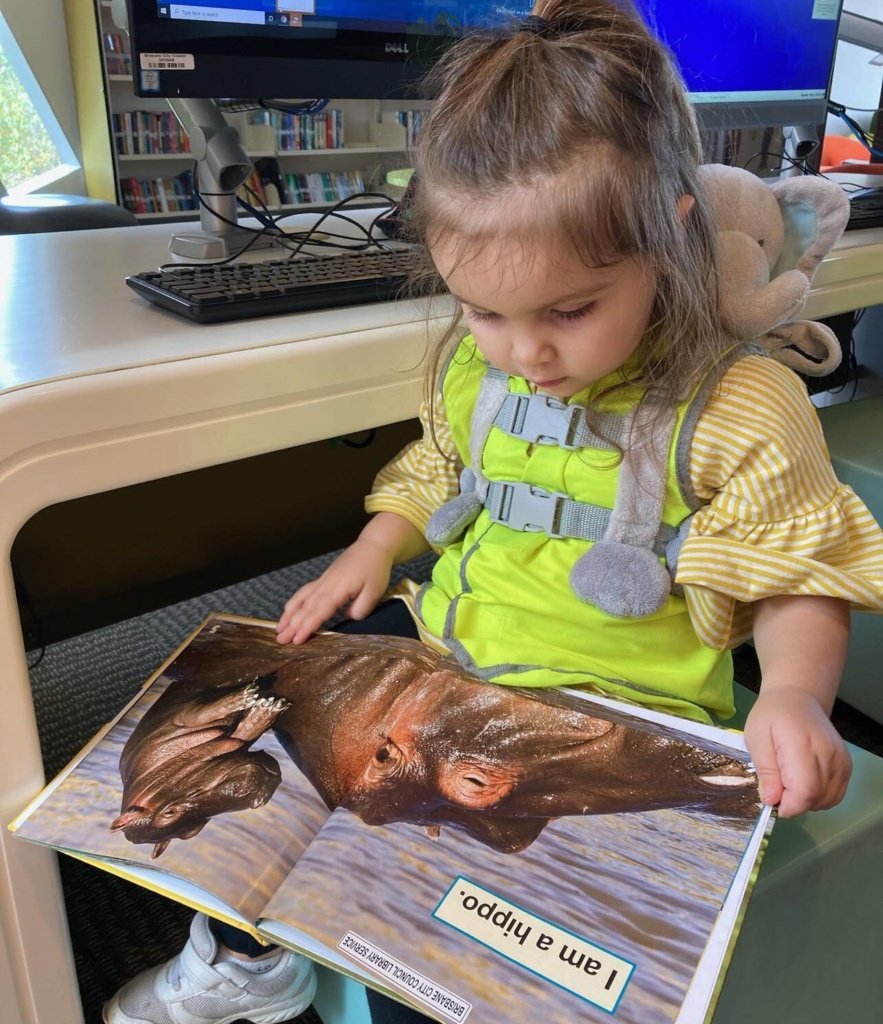
Learning to read really starts from infanthood, and is a big process. In fact, research has found newborns’ brains are prewired to be receptive to seeing words and letters. This means babies are already getting ready to read at birth. The relevant part of the brain, known as the “visual word form area” (VWFA), is connected to the language network of the brain, and was discovered by researchers at Ohio State University, who analysed the brain scans of 40 one-week-old babies, as part of the Developing Human Connectome Project.
Researchers compared these to similar scans from 40 adults who participated in a separate Human Connectome Project. The VWFA is next to another part of visual cortex that processes faces, and it was reasonable to believe that there wasn’t any difference in these parts of the brain in newborns. Because as visual objects, faces have some of the same properties as words do, such as needing high spatial resolution for humans to see them correctly.
But the researchers found that even in newborns, the VWFA was different from the part of the visual cortex that recognises faces, primarily because of that connection to the language processing part of the brain.
Lead researcher Zeynep M. Saygin’s team is now scanning the brains of three and four-year-old children to learn more about what the VWFA does before children learn to read.
Research has also showed babies can differentiate their native language from another language when they’re only hours old, which means they begin processing language in the womb. And, amazingly, studies have also found that at birth, the infant brain can perceive the full set of 800 or so sounds, called phonemes. Phonemes form every word in every language.
People can’t learn to read without understanding language, so your child has been working on learning to read since birth!
We encourage language development in many ways understanding that oral language is a significant aspect of early literacy, educators engage in song, rhyming and make use of picture books, to tell a story. Through our discussions and interactions with the children, and observations watching children play and what they’re interested in, we extend on their interests as part of our educational and intentional approach. So, for example, if educators see two children playing with toy dinosaurs, they may chat with them about why they’re interested. Then, they may have a conversation with the class about who else might be interested in dinosaurs. Based on the conversation, if many of the children are, they may set up sensory experiences, art opportunities and get relevant books on the topic of dinosaurs and read them together.
We also use words visually for many of our activities, even if they aren’t book-related, so that children begin to recognise words and associate them. Our environments place great emphasis to embed literacy print across all play spaces, this supports rich language experiences. Educators model words through children’s play, for example, when a child is engaged in block play, the educator will discuss the activity with them, exposing children to words, such as ‘you are putting a block on the top,’ (or underneath, or on the side.) These elements of language are also known as ‘positional language’ and introduce children to literacy and elements of numeracy at the same time.
At Little Scholars, we have a specific approach to learning to read. It’s called the 3a Abecedarian Approach Australia to reading. This is where children are active in conversational reading.
A long 1970s study in the US was the basis for the now well-adapted approach. The Abecedarian Project was a controlled scientific study of the potential benefits of early childhood education for disadvantaged children. Children born between 1972 and 1977 were randomly assigned as babies to either the early educational intervention group or the control group.
Children in the experimental group received full-time, high-quality educational intervention in an early learning setting from infancy through age five.
At the age 30 follow-up study, the treated group was more likely to hold a bachelor degree, hold a job, and delay parenthood, among other positive differences from their peers.
The 3a Approach encourages the adult and child to go ‘back and forth’ in conversation. There are three main levels to try – the first level is seeing, then showing, then saying.
Make it a conversation by asking your child to do something and not always following the words in a book.
“Can you see an owl? “Can you say owl?” “Can you show me an owl?”
At Little Scholars, we start with comprehension when looking at books – the thinking and talking about and enjoying the books we read together either in a group or one-on-one. Once children have a connection to books and reading, that’s when we can start teaching the ‘word parts’ of being a reader.
This is also something parents can and should do at home. Working with families is a core part of the Abecedarian approach! Parents are their children’s first educators, so we believe it’s to support families to grow in confidence as their children’s first educator, and reading together daily supports successful young readers. If you’d like to learn more, talk to your children’s educators or your campus manager for more information.
Read more:
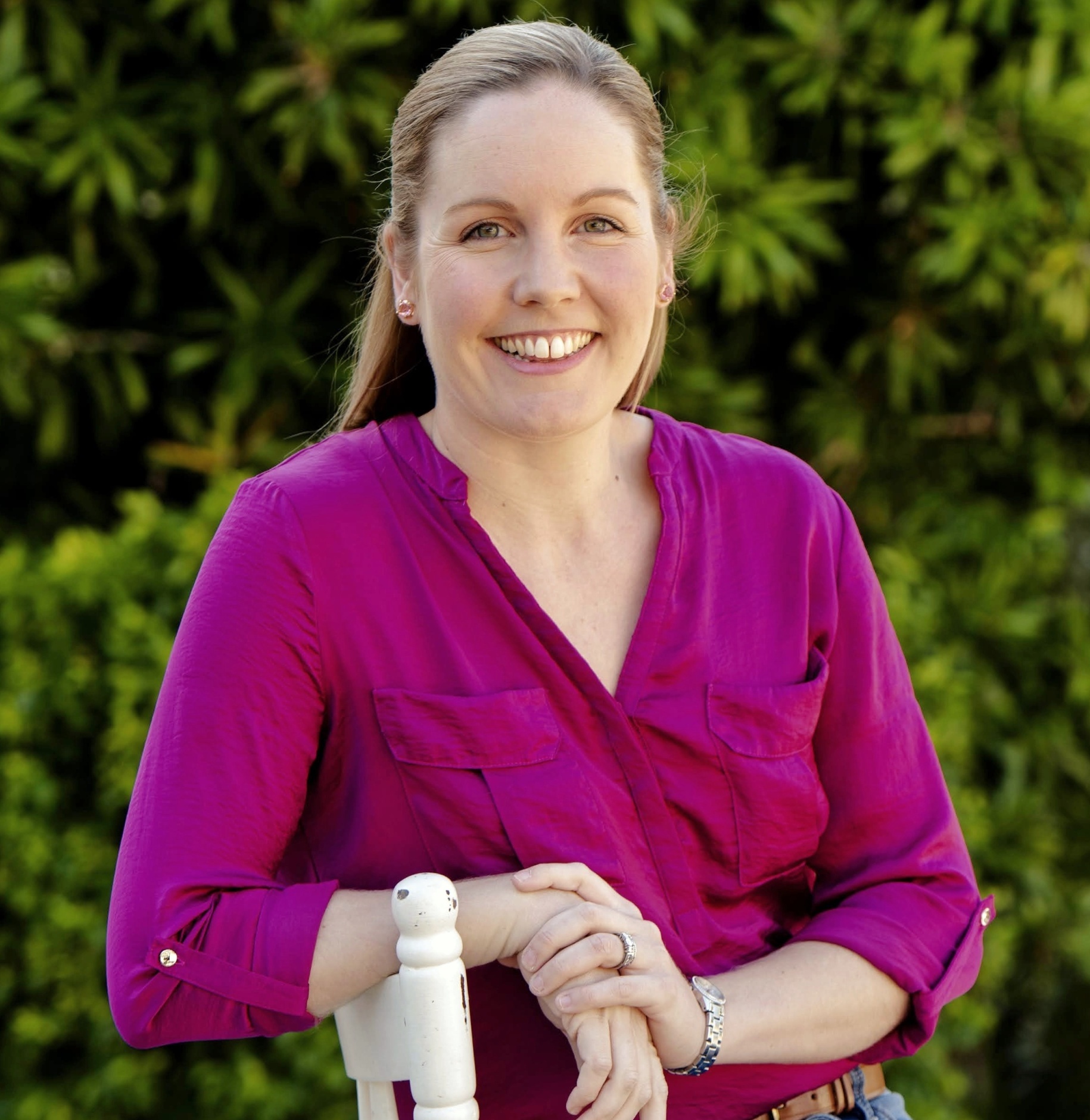
The festive season is here and the opportunities to get in the spirit are endless! Why not check your shopping list off at a Christmas market, jingle along at a carols concert or putt your way through a Christmas wonderland. To make sure you do not miss out on the festive cheer, here is your go-to guide with only the best of the best Christmas happenings picked out for you. Be sure to add these dates to your calendar!
Get ready for an exciting and interactive Santa show! Join Santa, Mrs Claus and Rudolf for a Christmas extravaganza that includes a mix of traditional carols and current pop songs.
Pacific Pines Central Park, 4-8:30pm
Image via City of Gold Coast

This free family festivity will feature live music, market stalls, inflatable fun, local restaurant specials, games and activities, plus a visit from Santa Claus.
Ron Short Park, 4-8pm
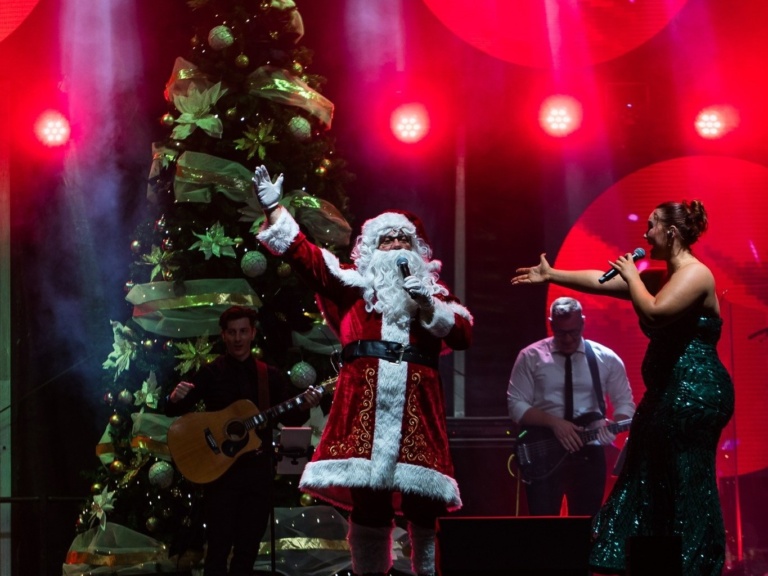
Bring your family for the largest carols event on the northern Gold Coast, an unforgettable night with fireworks, food vans, and festive sing-alongs.
Brien Harris Oval, from 4pm
Image via Northern Gold Coast Carols Facebook page

One of the all-time favourite Christmas carols will be performed in a 2-hour celebration of song and dance on the beach, with a visit from Santa, and a fireworks finale!
Surfers Paradise Beach, 5-8pm
Image via City of Gold Coast

Wind your way through the Market lanes to the sweet serenades of stunning live music, spot roving performers, snap a selfie with an elf… or meet Santa himself!
Home of the Arts, 4-9pm
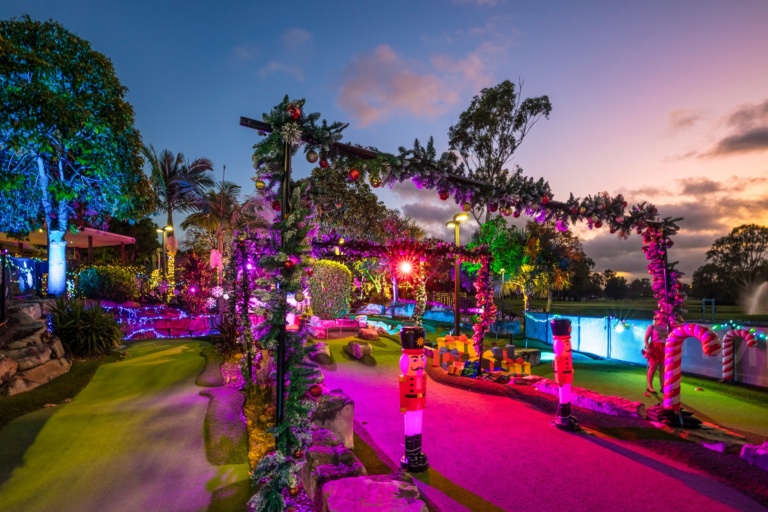
The elves have been busy transforming the 9-hole mini golf course into a spectacular Christmas wonderland!
76-122 Napper Road, Parkwood
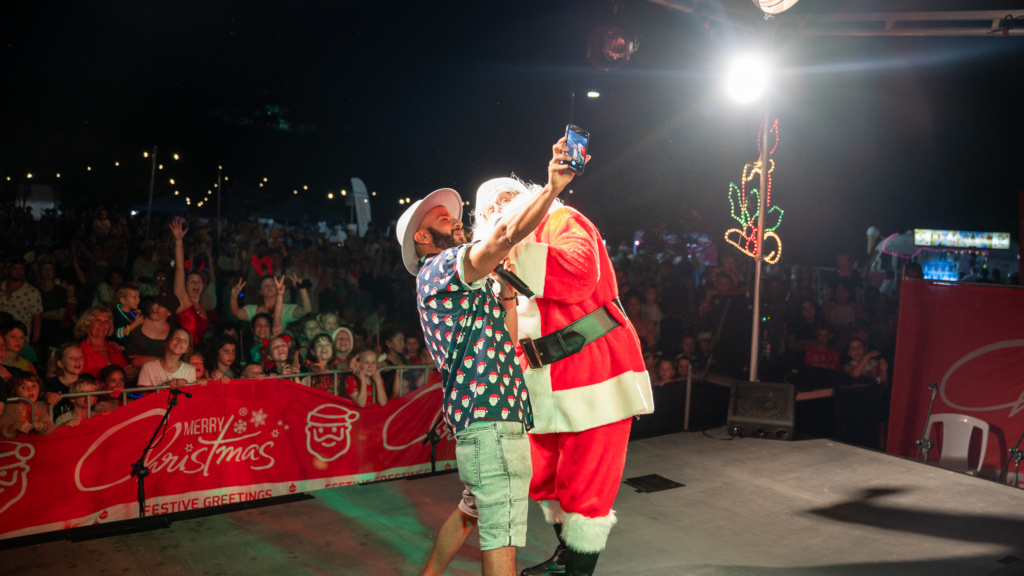
Free live music on stage, roving performers, children’s entertainment, fantastic food trucks, and Christmas market stalls. Plus see Santa making a special appearance alongside a fireworks display.
Ed Hardy Park, 4-8pm

Dine under the stars at one of the fantastic local eateries, check out the local business offerings, and visit the Christmas market stalls. Plenty of free children’s entertainment on offer throughout the program with Santa making a special appearance!
Toolona Street, Tugan, 4-8:30pm
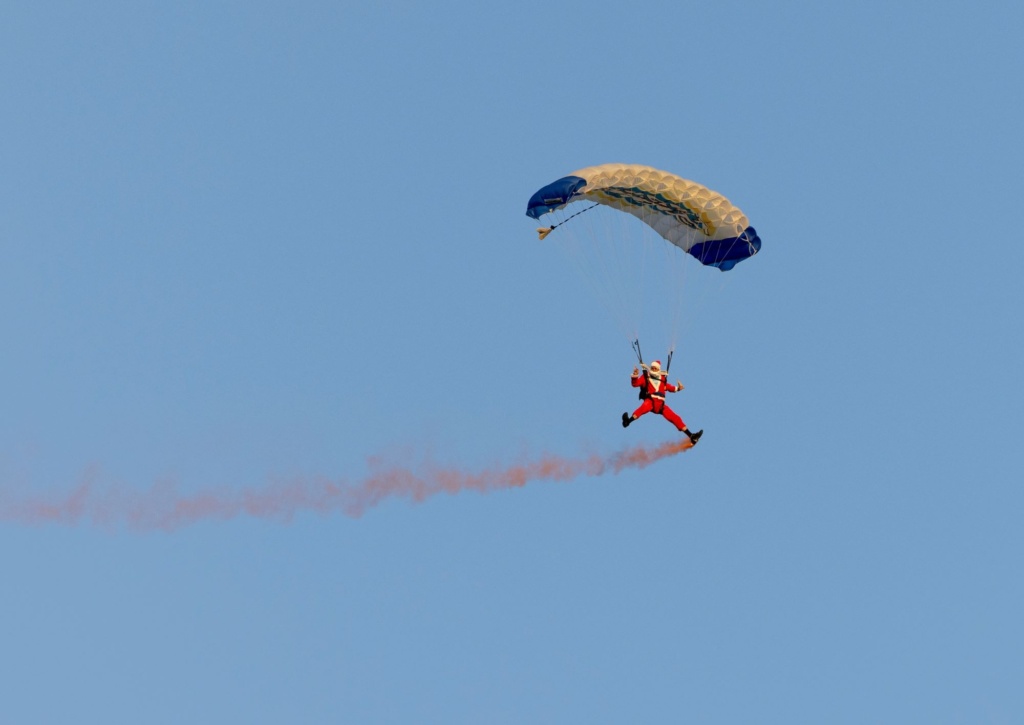
Sing along to your all-time favourite carols, enjoy a delicious assortment of food trucks, watch Santa fly in and watch a sparkling fireworks finale!
Queen Elizabeth Park, 5:30-7:30pm
Image via Shutterstock
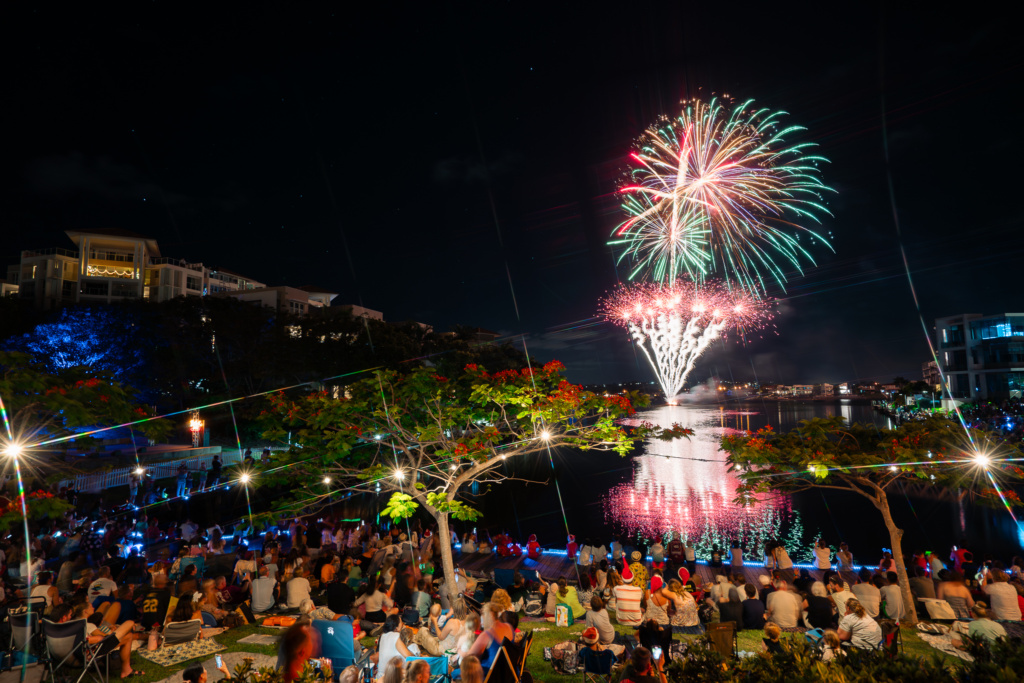
A truly unique festive celebration, this event will feature live stage entertainment, Christmas carols, Santa, Fireworks over the beautiful Lake Orr and much more!
Waterfront Stage, Varsity Lakes, 4-8pm
Image via Carols on the Lake Facebook page

A fabulous, family Christmas event with market stalls, food trucks, Santa, Christmas carols, live music, facepainting and free children’s craft area.
Mudgeeraba Showgrounds, 3-8pm

The City of Logan Christmas Carols is the city’s biggest annual Christmas event. This free, family-friendly event features hours of on-stage entertainment, festive activities, food trucks, and markets, all jam-packed into one magical day.
Kingston Butter Factory Cultural Precinct, 3-8:30pm
Image via Must Do Brisbane
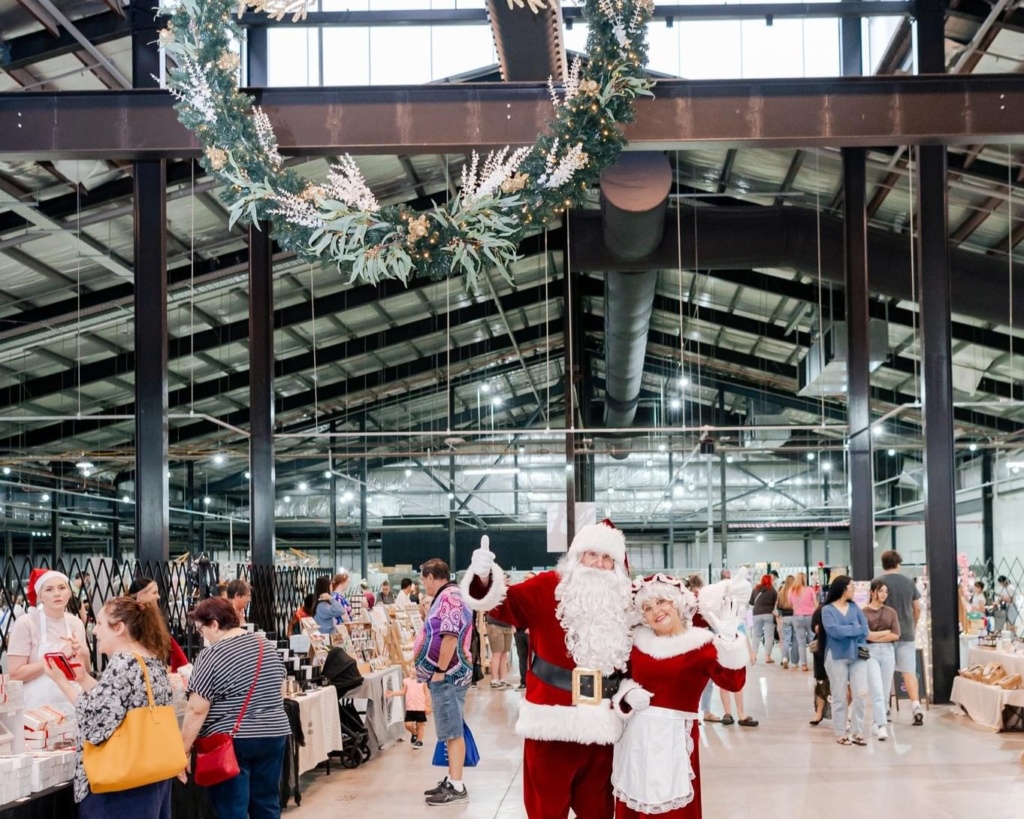
Experience a pop-up Christmas market brimming with a variety of local vendors, a special visit from Santa’s elves, and Mr & Mrs Claus will drop by for photos under a larger-than-life wreath, suspended above the Market Hall.
Distillery Road Market, 11am-9pm
Image via Facebook event

A free 7-minute light and sound show running at 6:30pm, 6:45pm, 7pm & 7:15pm. Get ready to catch all the “bubble snow” at the end!
Image via Redland Performing Arts Centre
If you’re looking for early education and care for your young family, look no further than Little Scholars!
We offer your child the very best facilities, resources and early educational, play-based programs available, which are underpinned by the early years learning framework. We also believe in fun, wide-ranging experiences so that children can begin to develop interests and passions of their own, from Bush Kinder adventures to our broad extracurricular program which includes swimming for our kindergarten children, we believe in keeping wonder and magic in childhood.
Find Lara’s recommendations at her website Mrs. Lardeedah.com, and follow her socials Facebook and Instagram
We adore the endless stream of questions that little ones bring to us every day! From an early education standpoint, we want children to learn at every opportunity. Children are inquisitive beings, and they have lots to learn! At Little Scholars, we cherish this innate curiosity in children and strive to foster a lifelong passion for learning.
As parents and educators, we understand that some questions from our little ones can catch us off guard, leaving us searching for the right words to provide age-appropriate answers. We’re here to lend a helping hand, so let’s tackle a few of these tough questions together!
How are babies made/how did a baby get in a mummy’s belly?
Children at this age are curious about the beginning of life. You can answer simply, “A tiny seed, called sperm, from the daddy joins with a special egg from the mummy, and that’s how a baby starts to grow inside the mummy’s belly.” They may understand it like a fruit grows from a seed. For young children, this should satisfy the question. You may want to explain it’s not the same kind of egg we eat for breakfast!
What does dying mean?
The concept of death can be challenging for young children to grasp. We think it’s important to be honest here. You can say, “Dying means that a person’s body stops working, and they don’t feel pain anymore. They don’t breathe, eat, feel hungry or cold. It’s a natural part of life’s cycle, like when leaves fall from a tree in the autumn.” This is a topic that may be followed up with further questions, such as ‘will I die or will you die?’ and be honest. “Yes, we all die. But I hope to be around for a really long time. I have no serious illnesses that could change that.”
What happens to us when we die?
For toddlers and preschoolers, you can offer a comforting response like, “When someone dies, they become like a beautiful memory in our hearts. We remember all the happy times we shared with them, and they will always be a part of us.” If your family has cultural or religious beliefs around death, this may be the place to share, “in our family and our culture/religion, we believe when the body dies ______.” Your child may work through this further through their play, but just be there for them and prepared to revisit this topic.
How come Louis has two dads?
Children may notice different family structures. You can say, “Families come in all shapes and sizes. Louis is very lucky to have two dads who love and care for him just like your mummy and daddy love you.”
Why does Ashley’s mum live in a different house from her dad?
When answering a small child’s question about why a couple has divorced, we think a simple, honest, and age-appropriate response that takes their emotional well-being into consideration works best. Here’s one way to address the question: “Sometimes, mummies and daddies decide to live separately because they have found they feel happier when they have some space. It’s like when friends need some time apart.
If it’s your separation, your child will need a lot of reassurance from you. “Even though mummy and daddy won’t be living in the same house, we both still love you very much, and we will always be there for you. You will have special time with both of them, and we will continue to love and care for you in different homes.”
Young children may have a limited understanding of complex situations like divorce, so keeping the explanation simple and reassuring them of their parents’ love is crucial. Encourage them to share their feelings and questions, and assure them that it’s okay to talk about their emotions. Creating a supportive and open environment helps children navigate through changes and emotions in a healthy way.
What happened in the news that’s making everyone so sad?
Addressing sad news can be tricky. Open the discussion by asking your child what they know about what’s happened in the news. This is a good opportunity to correct false information and provide context. Remember to use age-appropriate language. Check your child’s understanding throughout the conversation and allow them to ask questions. You can say, “Sometimes, sad things happen in the world, and it can make people feel upset. It’s okay to feel sad or worried, and we can always talk about our feelings with someone we trust. You can always talk to me about anything.”
I’m scared, why is the weather so bad?
Living in Queensland, while wonderful most of the time, also means we face all kinds of weather events, such as flooding, bush fires and extreme heat, and cyclones. Unusual weather can be scary for young children, so it’s important to stay calm and make sure the information you give them is age-appropriate and simple to understand.
It’s natural for children to feel scared, so reassure them with calm and simple words. Acknowledge their feelings and let them know they are safe. You might say:
“I can see that you’re worried, and that makes sense. These weather events can be scary, but we are safe. People are working hard to protect us, and we keep learning how to stay even safer in the future.”
Thunderstorms
Thunderstorms occur when warm, moist air rises rapidly into cooler parts of the atmosphere. As the air cools, clouds and rain form. Inside the clouds, lightning, a form of electricity, builds up. When lightning strikes, it heats the surrounding air, causing it to expand quickly and create the sound of thunder – BOOM! At the same time, cooler air sinks toward the ground, leading to strong winds.
Cyclones
A cyclone happens when warm air over the ocean rises up, creating a low-pressure area that pulls in cooler air, making it spin around like a whirlpool, and as the air gets higher, it cools down and forms clouds, bringing heavy rain and strong winds; basically, it’s like a big spinning dance of hot and cold air over the sea! These winds and rain can cause damage, but this is why we have emergency services to help keep us safe, and life will eventually go back to normal.
Flooding
Floods happen when it rains heavily for a long time, causing rivers, canals, creeks and oceans to overflow and water to spread onto land that is normally dry. It’s a natural event, and not anyone’s fault, and that while sometimes scary, there are ways to stay safe and prepared!
Bush fires
Bushfires happen when dry conditions, high temperatures, and strong winds cause trees and grass to catch fire. Sometimes, they start naturally, like from lightning, and other times, they are caused by people. Firefighters and experts work hard to prevent and control them to keep people and animals safe.
Why is the sky blue?
The secret behind the blue sky lies in something called “Rayleigh scattering”. It’s a fancy scientific term, but it’s a super interesting phenomenon that helps us understand why the sky is blue. When sunlight enters the Earth’s atmosphere, it interacts with tiny particles like dust, water vapour, and pollen. This mixing causes the sunlight to scatter, or spread out, in all directions. When light waves hit these particles, they bounce off and scatter in different directions, just like water droplets scatter after you throw a rock into a pond.
Now you might ask, “Why is the sky blue and not another colour?” That’s because blue light has a shorter wavelength than other colours of light, like red or yellow. Shorter wavelengths scatter more easily when they interact with the tiny particles in the atmosphere. So, when we look up at the sky, we see more blue light than other colours.
But guess what? The sky isn’t always blue! Sunrises and sunsets are not only beautiful but also full of science. The colours we see during these times depend on the angle of the sun and the distance its light travels through the atmosphere. The lower the sun is in the sky, the more atmosphere the light has to pass through. This causes shorter wavelengths, like blue and green, to scatter more, leaving the longer wavelengths, like red and orange, to dominate the sky. That’s why we see those breathtaking colours during sunrises and sunsets!
Clouds, pollution, and weather can also change the sky’s colour, making it look grey, white, hazy, or yellow.
Where do birds go at night?
Children might wonder where birds go when it gets dark. You can say, “Birds have special nests or cozy spots where they rest at night, just like we have our beds to sleep in.
How do plants grow?
Children might be fascinated by the growth of plants and flowers. You can say, “The plants have roots at the bottom that absorb water and minerals in the ground, and then the stem starts growing. With the help of the sunlight, the stem grows in branches. Green leaves start growing out of the branches. The five things plants need to grow are sunlight, water, minerals, and food..
Why do we have seasons?
Seasons happen because the Earth goes around the sun. The Earth travels around the sun, called an orbit, once a year or every 365 days. As the Earth orbits the sun, the amount of sunlight each location on the planet gets every day changes slightly. This change causes the seasons. When it’s closer to the sun, it’s warmer, and when it’s farther away, it’s cooler.
Where does rain come from?
Children may be curious about rain and weather. Sunlight heats up water on Earth’s surface. The heat causes the water to evaporate/dry up into the sky, or to turn into water vapor. This water vapor rises into the air and makes up clouds. As the water vapor cools, it turns back into water, in the form of droplets or rain drops.
How do airplanes fly?
Little ones might be fascinated by airplanes in the sky. “Airplanes have special wings that help lift them into the air. When they move forward, the air goes over and under the wings, which creates lift and allows the airplane to fly.”
If they have follow-up questions, we liked the answers from Britannica Kids.
Why do I have to go to bed early?
Children may question bedtime rules. You can say, “Going to bed early helps our bodies and minds rest and get ready for a new day of fun and learning.”
Why do I have to eat vegetables?
Answer with something like, “Vegetables have special nutrients that help our bodies grow strong and healthy. They are like superhero foods for our bodies! We need a variety of food that have different types of nutrients so our bodies can get everything they need to be the best they can be.
How come your body doesn’t look like mine?
We bet you thought the puberty question would come later! But nope, your child has noticed there’s a slight difference between their bodies and their parents’ bodies. We know this can feel awkward to answer, but your child doesn’t understand why it could be hard for their parents to explain, so use proper words and keep it simple.
It’s okay not to have all the answers, and it’s perfectly fine to keep explanations simple and age-appropriate. If you don’t have the answers, you can look it up together. By embracing your child’s questions and engaging in open conversations, you’re nurturing their curiosity and building a strong foundation for their learning journey. Be sure to let your lead educator know you’re having these conversations at home. Your child is likely not the only one wondering some of these questions, and your educators can find ways to help them understand life’s curiosities!
In recent years, news headlines have frequently highlighted the challenges surrounding men’s mental health, and the troubling rates of violence and suicide among men. While these stories are not representative of men overall, these issues don’t emerge overnight. They’re often rooted in childhood, shaped by how boys are taught to understand emotions, handle challenges, and connect with others. While these statistics are concerning, they also present an opportunity. If we start now, we can nurture a generation of boys who grow into kind, empathetic, and resilient men. If we encourage sensitivity, respect, and emotional awareness from an early age, we can help our little boys become the well-rounded, compassionate adults our world needs.
Raising both sexes present different challenges for parents, but really it’s a very individual approach to each child to ensure they’re learning to become kind, respectful human beings.
Traditionally, little boys have been taught to “man up” and avoid showing “weakness” by expressing emotions. This can be deeply isolating, leading to feelings of loneliness or frustration, and in some cases, acting out through belittling or bullying those who are more open with their emotions. In fact, a recent international study found that Australian teenagers experience bullying at the second highest rate among developed countries. The good news is that bullying numbers are showing a downward trend, suggesting that shifts in attitudes are making a difference.
By encouraging young boys to embrace and express their feelings, as well as having awareness of them in others, we can cultivate environments that support kindness and empathy, helping them build respectful relationships and healthy ways to cope with emotions. This approach is essential for raising well-rounded, compassionate individuals who understand that true strength comes from being open, understanding, and kind to themselves and others.
At Little Scholars, we believe strength comes from vulnerability, showing and sharing the range of human emotion, and understanding and displaying empathy rather than ignorance.
Our goal is to provide a secure and trusting environment in which all children feel a sense of belonging. We support children to form positive relationships with peers, educators and their environments, while recognising and maybe improving their existing relationships with their family and community.
Part of building and maintaining these relationships means teaching children to recognise the range of emotions within themselves and in others. This in turn builds empathy, understanding and respect for others. We do this in a variety of age-appropriate ways to support children’s emotional development. From understanding what the various feelings are, understanding how they feel, how to see these in others, as well as mindfulness practices to deal with harder feelings when they arise.

To get an understanding of some of the potential reasons for what’s happening in males, what we can do now, we spoke to Dean Cooper, the program manager for White Ribbon Australia, a not-for-profit global social movement working to stop men’s violence against women. The organisation’s mission is to strive for a society where all women and children are safe. November is White Ribbon Month in Australia, we encourage you to visit the White Ribbon Australia website and contribute if you can.
Dean also happens to be the proud dad of two little boys, one of whom is pictured with Dean in the top photo and attends Little Scholars. We’re thrilled to have Dean’s expertise on this important topic.
I design programs for high schools and workplaces on domestic violence (DV), masculinity, respectful relationships, consent, etc. Secondary to my role at White Ribbon Australia, I am an ambassador for the innerBoy app which is an app assisting men to heal from trauma and get support for any mental health challenges they are facing.
Well, originally I wanted to play Rugby Union professionally, however that didn’t work out, so I studied criminology and undertook a career in corrections, conducting assessments on people who committed offences of all kinds. I began to focus solely on working with men and fathers who used violence, and about seven years ago I started facilitating men’s behavioural change programs for men being released from prison for DV offences. Quite alarmingly, what I learnt was a lot of behaviour I engaged in within sporting environments, such as sexist jokes, violent chants, and street harassment on nights out, actually made their way into these programs, and condoned or supported a lot of problematic beliefs these men who were using violence had. It was my full circle journey to realising that not all disrespect leads to violence, but all violence starts with disrespect. I’ve decided to stick with this work and found a passion for it as I think it’s important that those who are being disrespectful or choosing to use violence receive counter narratives from culture to say these behaviours aren’t okay.
I am passionate about the role men play in shaping children, especially boys, and have a desire to see every father role-modelling safe and respectful behaviour. I truly believe safe, engaged, and present fathers can positively impact our future generations and are the solution for the social issues we see today. Unfortunately, what I’ve learned in this work is that a lot of men either didn’t have positive role models growing up, or look around at music, TV, movies, pornography, social media, etc. and have no mainstream examples of what positive, safe, and effective fathering looks like. It’s my passion to create spaces for men to learn what fathering means and how we role model respect, equality, and safety.
There isn’t much at such a young age that we can ‘teach’ in that formal sense. Children will learn from observing so it’s important we role model more than try and teach. I’ll just provide my own strategies.
One thing I am trying to personally do is role model accountability. If my son says something like ‘that makes me sad’ or ‘I don’t like it’ if I am playing, or implementing a boundary I try to talk to him about why it upsets him and validate his feelings. I also role model saying ‘sorry’. Likewise, with my wife I make a purposeful attempt to apologise for things and role model what it’s like to get it wrong and change my mind. It’s crucial to show we don’t always have the answers, we are going to make mistakes, but we can always acknowledge our impact and make amends.
I try to hold myself proactively accountable as well. As adults, we know when we haven’t done our best work. If we are distracted on our phone when our child tries to engage us, or if we snap at them for not doing something we asked, or if they are talking and we interrupt with something else. We can proactively hold ourselves accountable, I try to say ‘son, when you were talking then I realise I wasn’t fully listening and I am sorry, what you have to say is important and I recognise by not listening I didn’t show that.’
“I also believe we play a huge role in teaching our boys to regulate their emotions. We seem to be better at comforting girls or more accepting of their emotions. In terms of our boys, we need to shift from correction to connection.”
Another, ‘I’m sorry I yelled before, it’s my responsibility to stay calm and I didn’t do that, it wasn’t my intention to make you upset but I realise it did, I am sorry for that and next time I am going to do better.’ If I see my son be unkind to someone in the playground or at kindy drop off, I try use those moments to ask him what he thinks the impacts were and how we can make amends. For example, ‘I saw when you took those two toys and didn’t give one to Johnny. Look at Johnny now, does he look happy or sad? Johnny looks sad and I think it’s because he doesn’t have a toy, can you help me find a way for Johnny to have a toy too?’ and layer that in with an apology for not sharing. Taking those steps to encourage my son to see the impact they have on others, be comfortable with reflecting on what they’ve done, and how to repair. That’s how we start to shape kind, reflective, and safe boys.
At least once a week, I try:
1. Admit a mistake I made
2. Share what I learnt about that mistake
3. Ask for help.
This is how we mark ourselves as a psychologically safe person. If we can role model getting it wrong, learning from that, and being willing to accept help, we role model that we are a safe person to hold accountable, we’ll treat their mistakes with empathy and understanding, and it’s okay to make mistakes. If we can mark ourselves as safe people by role modeling this, then we normalise recognising the impacts we have on others and repairing those. I just never want my children to hide something from me because they felt like they couldn’t tell me. I don’t want them to say ‘I made a mistake don’t tell Dad’ and instead say ‘I made a mistake I have to tell Dad.’ That’s the goal.
I also believe we play a huge role in teaching our boys to regulate their emotions. We seem to be better at comforting girls or more accepting of their emotions. In terms of our boys, we need to shift from correction to connection. Again, I think we need to role model this and talk about when we are frustrated, sad, disappointed, happy etc. I speak with a lot of dads who openly state at times they’ve been sad or angry, their children will ask ‘Daddy, are you okay?’ and they respond ‘Yeah, I am fine’ when they really aren’t. Children are these perfect little emotional barometers and what we actually do in that moment is not protect them from any negative feelings, but lie to them and tell them their sense of emotions was wrong. Instead, I try and role model ‘Daddy is feeling sad right now, thanks for noticing and asking if I am okay. When I feel sad I like to find an activity that makes me happy or find Mummy and give her a big cuddle.’ It’s important we teach boys to recognise their emotions, deal with them, and implement strategies to cope.
Physical affection is so important. As a guy growing up I always heard about this ‘tough love’ approach to parenting and the whole ‘just wait till your Dad gets home’ disciplinary role we were supposed to play. In my career, I’ve worked with a lot of men who have poor emotional regulation or traumatic backgrounds and they all report a lack of being told they are good enough and to be embraced. We do some exercises in prison groups where the men outline what they wish they had more of as children, all of it comes back to being told they were of value just as they were, and wishing they were shown love more.
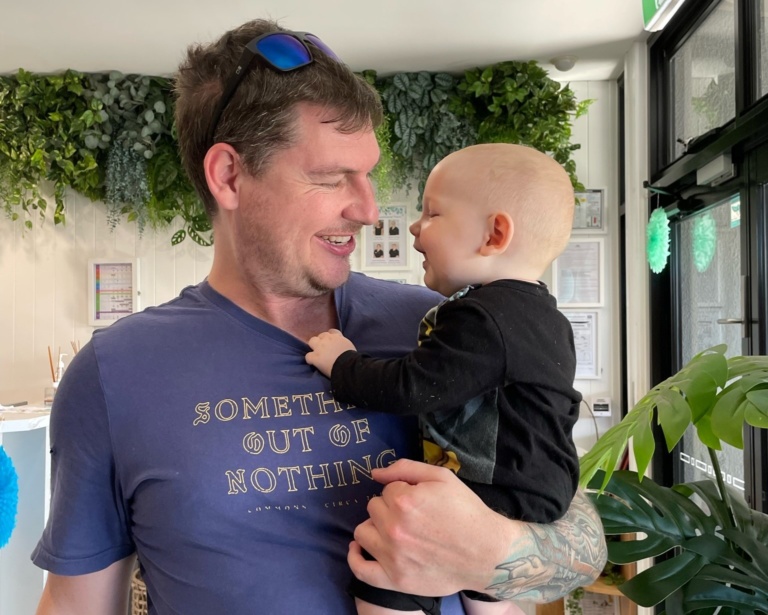
At Little Scholars, we feel strongly it takes a village to raise a child, and we’re very proud to be a part of your child’s community as she or he grows and learns about the world. All of our little scholars learn about emotions in a number of age and developmentally-appropriate ways. It’s a very important facet of our early educational curriculum, supported by the Early Years Learning Framework.
We aim to provide a safe and secure space in which they grow and thrive. To ensure we’re doing this, we’re constantly working to improve our knowledge and practices. Our educators regularly take on professional development that helps them understand and guide children through not only their letters and numbers, but their emotional and social growth, on topics like developing mindfulness practices in their studios, developing frustration tolerance even more specific learnings such as trauma-informed practice.
Of course, ensuring children’s safety is paramount, and our educators are also regularly trained and updated on Child Protection Policy and procedures.
If you have any questions or concerns about your child, we have an open door policy and we invite you to talk to your educator, educational leader or campus manager any time.
Little Scholars offers you and your child the very best facilities, resources and early educational, play-based programs available, which are underpinned by the early years learning framework. Our belief is that through quality education and care for children we can also encourage, assist and support the entire family.
Our dedicated team of educators are committed to the individual needs and interests of children and their families, and thus we encourage and welcome family input and involvement.
We aim to be like an extension of your family and are very relationship-driven. We support nurturing relationships between our educators and your child, the relationships your child has with the other children who attend, and we value our relationship with you as the parent and other family members. So book a tour today to get started!
As Little Scholars celebrates its milestone decade of educating and caring for South East Queensland children we met up with Jae Fraser, the founder of Little Scholars, to hear his memories and reflection of the past 10 years operating Little Scholars School of Early Learning! For a bit of background on Jae, he’s spent more than half his life educating young children.
After years working in the early learning and care sector, starting as a trainee and working his way up to early childhood teacher and campus manager, Jae eventually became general manager of Australia’s largest ASX-listed childcare company. But he felt a constant pull to do things differently. This drive led him to purchase his first Little Scholars campus, a run-down campus in Yatala. Ten years later, Little Scholars now educates more than 7,000 children across 16 campuses and employs more than 600 staff.
From the beginning, he wanted to offer what no one else did. The result for families who are enrolled with the Little Scholars School of Early Learning are innovative offerings such as chef-prepared take home meals for busy parents who don’t have time to cook, as well as our Family Time program that offers specialist appointments as well as dental and haircuts so families can use their free time together. Little Scholars was one of the first to introduce Bush and Beach Kinder in Queensland, all of this as well as first-class education and care in beautiful spaces to play and learn.
As a passionate teacher, I never thought I would find myself in a corporate role as a general manager of a company with more than 500 centres and 6,500 staff, but I loved every moment of it, especially the people I had the pleasure of working alongside. I’d always felt a deep conviction about early learning. It’s absolutely more than a career, it’s my calling. I was incredibly proud of the work we did in my previous role, but I kept dreaming of something that could be even more child-centered, community-focused, and creatively enriching.
I wanted to create something different, something that families and educators hadn’t seen before, a space where children could explore, get messy, learn about kindness, and discover the world on their own terms, environments that . I had a vision to create an early learning centre unlike anything in the market—an elevated, high-quality experience where every environment is thoughtfully designed to inspire wonder, nurture growth, and offer a truly exceptional foundation for young learners.
Little Scholars was born from that vision. I didn’t leave because anything was missing per se, but rather because I knew there was something special, we could create that could go beyond the traditional expectations in early childhood education. Little Scholars was my chance to bring that vision to life fully.
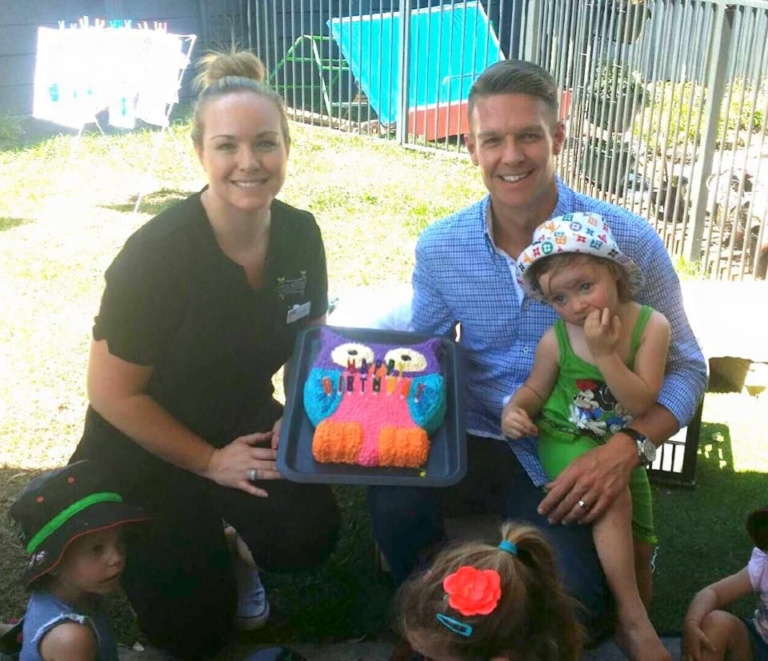
Opening the Yatala campus was exhilarating but incredibly intense (and so so stressful). In those first few months, I was wrapping up my role as general manager, while putting everything I had into Little Scholars at Yatala. It was chaotic, but the kind of chaos where every long day, every sleepless night, felt like it had real purpose. There were times when I felt that I had taken on too much and was I ever going to get there?
When I eventually stepped away from my GM role to focus solely on Little Scholars, it was already showing the spark of what it could become. People were resonating with what we were building, a place where families felt at home and children felt empowered, and that was everything I’d hoped for.
We started with nothing but a dream, pouring all our savings into opening that first campus; with limited funds, we did everything ourselves – cooking, cleaning, gardening, renovating, and managing every detail to bring our vision to life while building a new business from the ground up. Honestly, I’ll never forget those early days. Family, friends, our new team, and even complete strangers chipped in, offering hands-on support, encouragement, and assurance. Andrew was there by my side constantly, and the team that joined early on was absolutely invaluable – they believed in Little Scholars right from the start. Local families and businesses welcomed us, and that sense of community support really set the tone for everything we’ve done since.
I also remember families telling us that they drove past four other services, to come to Little Scholars – they loved it that much and so grateful for what we were creating for their children. Little Scholars became a destination early learning facility, a place families were willing to travel to because of our never-ending commitment to education and our philosophy of learning through play, where every experience is designed to ignite curiosity, joy, and a lifelong love of learning.
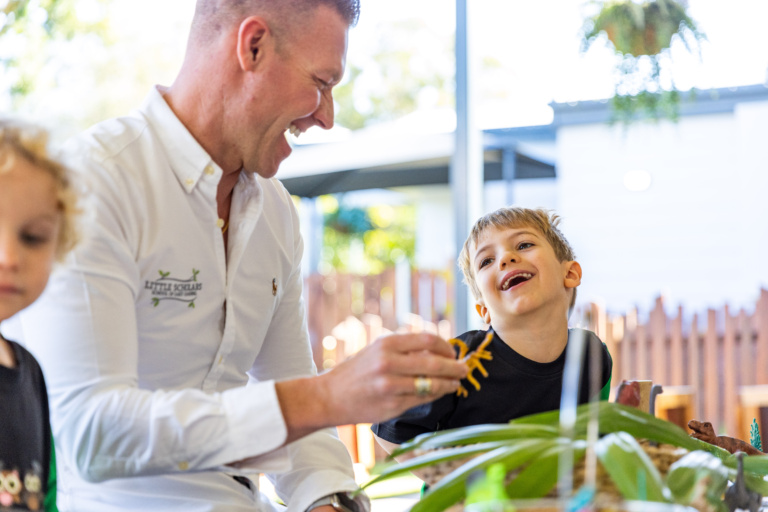
The scariest part was wondering if this dream was something I could actually bring to life. If I could truly build a place where children would feel that they belonged and where parents felt absolute trust. Another was the relentless hours, working 15-16 hours a day, seven days a week, with barely enough funds to keep us going. I was constantly worried about whether we’d ever make it. We were now employers, responsible for our team’s livelihoods, knowing they depended on us to help pay their rent and mortgages. On top of that, there was the pressure of delivering on every promise I’d made, ensuring that our vision didn’t just stay a dream, but that the outcomes we set out to achieve would truly come to life.
There were days I’d wake up worrying about all the unknowns: ‘Will families see the value in what we’re doing? Will children thrive here the way I envision?’ But every time I walked into the Yatala campus and saw the smiles on those little faces, it reaffirmed that we were on the right path.
I remember when the moment I thought, ‘Oh my goodness, this might just work,’ so vividly. I mean, each Monday morning, after a weekend spent making improvements, we’d see the amazement on the children’s faces, the excitement in the educators’ eyes, and the families’ appreciation for what we were building. But the real turning point was our Open Day. Over 500 people came through, and the response was overwhelming! Families were captivated by the environment and everything we had created.
One of my friends, who had just come to visit, ended up taking enrolment fees on the EFTPOS machine because people were lining up, eager to be a part of it. Seeing that level of enthusiasm and belief in what we were doing was when I realised this dream was resonating with others in a big way.
I watched children running into the campus with huge grins, so excited to start their day, and I thought, ‘we’re onto something.’ Families would tell me how their children talked about their teachers, their new friends, and the garden we’d planted together. That’s when I knew this wasn’t just a service, it was really becoming a meaningful part of people’s lives. And even 10 years later, that feeling never gets old.
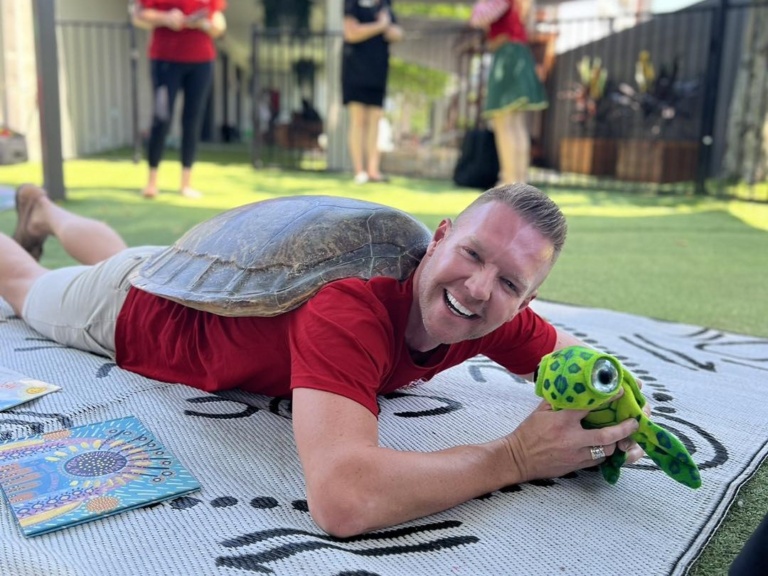
Oh, there are so many memories from those early days! I remember the late nights spent painting walls and bike tracks, filling sandpits, washing buses, planting gardens and laying turf until my hands were blistered. It wasn’t glamorous work, but it was honest and heartfelt, and every effort meant we were creating a place that was genuinely ours to share.
One memory that’s always close to my heart is my best friend Mel bringing her little boy into the campus on weekend to help while we were still setting up. He’d toddle around, exploring every corner as if he were inspecting our progress, and his joy and curiosity reminded me of exactly why we were doing this. Countless weekends were spent working alongside friends and family, all of us taking a quick break in the playground, enjoying a Yatala Pie before moving on to the next task.
Those moments of shared effort and laughter laid the foundation for everything Little Scholars stands for today.
Another of my biggest dreams in starting Little Scholars was to make it possible for educators to become teachers without facing the same struggles I did coming from humble beginnings. I always hoped that one day I’d be in a position to support others on that journey. I’ll never forget the day an educator at Yatala mentioned they wanted to study to become a teacher but couldn’t afford it. In that moment, I was able to look them in the eye and say, ‘I’ll fund your study and support you every step of the way to help you become a teacher.’ That educator is still with us today, teaching at our Yatala campus, and their journey is a constant reminder of what Little Scholars is truly about.
Looking back, it’s incredible to think that five campuses once felt like a dream, and now, with over 17, we’re just getting started. In the next 10 years, I see Little Scholars as a leading light in early childhood education, not through size or numbers, but through our commitment to quality and impact. We’re dedicated to refining what we do best, focusing on the growth and development of every child, and ensuring our teams have the support and professional opportunities to grow their careers and reach their potential. We’ll also continue to participate in meaningful research and projects to improve the educational journey and outcomes for children, even beyond Little Scholars. Our goal is to deepen our connections with families and communities, staying true to our heart-driven purpose to create spaces where each child feels seen, heard, and genuinely valued.
It’s about holding onto what makes Little Scholars special and continually raising the bar in early learning.
As the year draws to a close, our thoughts eagerly turn to the holiday season. After all, it should be a time for rest, cherished moments with family, enjoying all things Christmas-themed! What’s better than snuggling up on the couch, next to a brightly lit tree, watching a Christmas movie together? We know parents are busy, so we had a look at the best Christmas movies for children, for the entire family, and where you can find them!
We’ve included run times and recommended ages, as well as where to find these movies to make things easier and quicker for families!
For parents who want a little extra comfort that they’re showing their children age-appropriate content, we suggest heading over to commonsensemedia.org and looking up movies there. Common Sense has been the leading source of entertainment and technology recommendations for families and schools, and they champion high-quality media, ‘support closing of the digital divide, ensure that students and educators think critically about technology use, and more.’ Its mission is to create a safe, healthy, and equitable digital world for children and families.
The Polar Express is a newer Christmas classic. In this heartwarming story, a young boy’s belief in the magic of Christmas is rekindled when he journeys to the North Pole aboard the Polar Express on Christmas Eve, where he meets Santa Claus himself. This year, you can find The Polar Express on Netflix. Ages 8+. Run time: 1 hr 30 min.
Based on the beloved book by Dr. Seuss, The Grinch tells the story of a grumpy character who becomes fed up with the endless festive cheer in Whoville. With his loyal dog by his side, he sets out to dampen the holiday spirit. While there is a live-action version of this classic, we recommend the animated version as a perfect choice for little ones! This can be watched or rented on Binge, Apple TV and Amazon Prime! Ages 6+. Run time: 1hr 30 min.
Another newer Christmas classic, fan favourite Will Farrell plays Buddy, a fun-loving man raised by Santa’s elves, who makes his way to New York for a holiday adventure. Elf can be found on Binge, Stan, Amazon Prime Video, Apple TV and more! Ages 8+. Run time: 1hr 30 min.
Based on the Broadway musical inspired by the popular Christmas movie, Elf tells the story of Buddy the elf and his journey to find his long-lost father. While Buddy’s cheerful spirit fits right in at the North Pole, it clashes with the tough crowd in New York City. But with song, dance, and endless holiday cheer, Buddy brings the Christmas spirit back to the whole city. Watch on Amazon Prime and Apple TV, Ages 6+. Run time: 45 minutes
These cheeky talking animals had a holiday heist all planned out, but their scheme is turned upside down when Christmas is cancelled. Join the Bad Guys on a gift-giving adventure as they work to bring back the festive spirit for everyone. There are some instances of cartoon violence, mild insults, but Common Sense Media gave it four out of five stars, so we trust their judgement! Find it on Netflix! Ages 6+. Run time: 25 minutes
When Shaun’s hunt for a bigger stocking hits a snag, the whole farm sets out on a wild holiday adventure — complete with a sleigh! You can find this cute tale on Netflix. Ages 5+. Run time: 52 minutes.
This delightful story follows a young boy and his trusty rubbish truck as they spring into action to save Christmas when Santa crash-lands in their junkyard on Christmas Eve. Expect plenty of laughs, adventure, and holiday cheer! You can find this one on Netflix. Age 3 and up. Run time: 28 minutes.
Christmas is all about nostalgia, so we wanted to share some movies our families may have loved growing up and are keen to share with a next generation, so parents and grandparents, we’ve got you covered!
Of course, there will be movies such as Home Alone and A Christmas Story that many of our parents remember fondly, but with their violent or weapon themes, we thought it was best to leave them off the list! These movies can be found on some of the streaming sites we mentioned, but maybe wait until after little ones bed times before viewing again!
A spin on the Dickens’ classic by the legend Jim Henson. Many parents will have grown up watching and adoring this one, we just warn the ghosts or Mr Scrooge might be scary to young children. Ages 6+. Run time 2 hours.
You can find this on Disney +, Apple TV, and Amazon Prime.
Parents and grandparents, bring your childhood nostalgia to the next generation with 1960s classic Charlie Brown’s Christmas! With Christmas approaching, Charlie Brown is unhappy as everyone associates the holiday with presents. He tries to understand the true meaning of the festival and his friends decide to help him. This can be found on Apple TV. Ages 3+ Run time: 25 minutes.
An oldie but a goodie! This one can be watched on Apple TV. (pssst, you get seven days trial to use Apple TV if you don’t already subscribe)
Fun fact about this feature: Rudolph was created using stop-motion. The animation technique was called Animagic, a painstaking process where jointed, wood-and-felt puppets were moved ever-so-slightly for each new frame. It took about 18 months to shoot a half-hour special! More fun facts including this one can be found here! Ages 3+. Run time: 53 minutes.
This 1980s classic will be a fun return to parents’ childhood with everyone’s favourite lasagna-eating cat Garfield. In A Garfield Christmas Special, our favourite surly cat heads to the family farm for an old-fashioned holiday with Jon’s mum and dad, his brother Doc-Boy, and their feisty grandma, who’s truly the cat’s meow. You can stream for free on YouTube, and it also can be found on Apple TV. Ages 3+. Run time: 24 minutes
We’ve put together this list to make it easier for your family to enjoy a little extra Christmas joy and share in the magic of the season. Whether it’s a cozy movie night, a fun family activity, or finding some rare moments together, we hope this guide adds a touch of festive cheer to your holidays.
If you’d like to nurture curiosity, joy, and lifelong skills in your child, book a tour at one of our 15 Little Scholars campuses. See how our team is dedicated to helping incredible children grow into incredible people, building bonds and confidence that will last a lifetime.
Ipswich! You may have heard Little Scholars School of Early Learning is coming to you! We’re thrilled our newest campus is coming to Ipswich in early 2025. As we prepare to open our doors, we want to celebrate by sharing some of our favourite family-friendly activities in Ipswich, because we’re not just about early learning, we adore our families and our Ipswich community!
We think Ipswich has really stepped up its game when it comes to offering some great entertaining offerings for the young, and the young at heart.
Images and information courtesy of the organisations mentioned below, as well as Brisbane Kids, Ipswich First, Families Magazine and Must-Do Brisbane.
Did you know Ipswich has Australia’s only public library dedicated to children? It features a specially designed catalogue with over 35,000 books just for children, and unique multi-reality interactive experiences.
The Ipswich Children’s Library is designed to be an interactive and engaging space for children. It features various zones with elements that encourage exploration and active participation. Highlights include a series of colourful tubes where children can send fabric pieces flying through the air, large interactive screens, and colouring tables where children can scan and watch their decorated fish swim on a screen. The library also offers cosy reading nooks, a gaming touch screen with STEAM-based puzzles, and a unique Reading Tree with a cushioned tunnel for reading. The space is filled with natural light, thanks to its floor-to-ceiling windows overlooking the Nicholas Street Precinct and landscaped gardens.
The library is open seven days a week and hosts regular, child-focused programs and events and special tech adventures just for little ones!
Hop aboard the Queensland Pioneer Steam Railway in Ipswich for a fun-filled family adventure. Ride in beautifully restored vintage carriages and explore the rich mining history of the area. As the train chugs along, you’ll pass by old mine ruins and vintage equipment, giving you a glimpse into Ipswich’s past. It’s a perfect outing for families to enjoy a unique and educational experience together.
Attention all young aviation enthusiasts! Visit the RAAF Amberley Aviation Heritage Centre near Ipswich to see some amazing aircraft up close. Walk around and marvel at the F-111 with its famous “dump and burn” feature. Check out the WWII Boston Bomber, Vietnam-era Canberra bomber, Caribou airlifter, Sioux and Iroquois helicopters, and WWII Jeeps. You’ll also see cool Sabre and Mirage fighter jets. Learn about the RAAF’s important role in history with interactive exhibits and displays. It’s a fun and educational trip for the whole family!
Check the website for times to visit.
Ipswich Art Gallery takes play seriously! Its goal is to create dynamic pathways for lifelong relationships with art.
It’s a visual arts and social history museum presenting a dynamic program of exhibitions and heritage displays with complementary workshops, performances and an extensive program for children and families. We also adore that the gallery guides itself by philosophical principles for its children’s gallery, highlighting that learning begins with creative play, and that children are important members of our community who should be encouraged to express and develop their ideas and views.
Located in Queens Park, the Ipswich Nature Centre offers a delightful experience for families and nature enthusiasts. This free-entry zoo showcases native Australian wildlife, including kangaroos, emus, wombats, and bilbies. Wander through lush gardens, see barnyard animals, and enjoy the aviary filled with colourful birds. The centre provides an educational and fun outing, promoting conservation and the beauty of local wildlife.
For more information, visit Ipswich Nature Centre.
Discover the rich history of Ipswich at the Cooneana Heritage Centre, home to the Ipswich Historical Society. Explore historical photographs, artifacts, traditional crafts, and coal mining displays that highlight the region’s diverse past. Visit Cooneana Homestead to see early Ipswich life, and Jim Donald House, a well-preserved miner’s cottage from the 1890s. Experience an old-fashioned classroom in the schoolroom and watch blacksmiths at work in the blacksmith shop. Perfect for history enthusiasts and families alike.
Take an eye-opening journey through Queensland’s history at the heritage-listed Ipswich Railway Workshops. The award-winning Queensland Museum Rail Workshops is a must-visit for anyone in Ipswich. Once employing over 3,000 railway workers and making it Queensland’s largest employer at the time, this historic site now blends the charm of the past with modern technological advances.
Explore the old boilershop, home to beautifully restored locomotives and carriages, and marvel at Queensland’s largest model railway, showcasing detailed scenes of the state. Perfect for visitors of all ages, this museum brings history to life.
Check out Faye Carr Park in Ripley, a rocket ship-themed playground designed for the whole community.
The standout feature is the impressive trio of red and green pods, which have become a landmark of the Ecco Ripley development since its opening in 2018. These custom-designed pods by Playscape Creations are a first for Australia, offering sensory delights like cogs, steering equipment, and rainbow spinning wheels, all connected by a bridge. The exterior is just as engaging with ladders, slides, staircases, and fireman poles for endless fun.
For younger children, there’s a separate toddler playground complete with a mini slide, ladder, and puzzles. The area also includes a five-person swing circle, a rotating net climber, a see-saw, and a double-track flying fox for inclusive play.
Sports enthusiasts will enjoy the middle section of the park with multipurpose fields for soccer, rugby, and basketball, as well as an outdoor workout zone. Picnic shelters and BBQs make it perfect for a family outing.
Over 20 developmental activities between the main and toddler playgrounds promote educational play in a fun outdoor setting. The park also emphasises social play with shared swing circles, rotating net climbers, and multi-track flying foxes, encouraging greater participation.
The parklands are wheelchair and pram friendly, with accessible pathways connecting all areas. The seated playground equipment, including an adaptive swing, see-saw, and net climber, are designed for inclusivity.
Faye Carr Park Features:
A multi-million dollar playground that is accessible and engaging for all ages is the incredible result of a consultation between locals and Orion Shopping Centre.
The main attraction is a vibrant activity centre with a tower reaching 11 metres high, accessible via internal ladders or a 16-metre Sky Walk bridge offering a birds-eye view of the playground below. Two enormous tunnel slides flank the tower, perfect for young thrill-seekers. Note that the play area is not fenced from the nearby car park, so close adult supervision is necessary.
For children who prefer to stay grounded, the playground features in-built trampolines, mountaineering ropes, and a large climbing net tunnel. A wheelchair-friendly merry-go-round promotes inclusive play.
The toddler area includes slides, stairs, a rock climbing wall, a fire pole, a colourful see-saw, and a cognitive play hut with educational activities. Swings are available for both independent children and those needing assistance. Most of the playground is covered by shade sails or roofing for sun protection.
Lobley Park is a charming, aviation-themed park that pays tribute to Ipswich’s Air Force heritage. Children will love playing in the aeroplane structure, exploring the air traffic control tower, and enjoying the parachute swings. The park also offers ample space for running around, traditional playground equipment like swings and slides, and a story time area. Perfect for picnics or parties, Lobley Park features barbecues and tables. It’s a fantastic spot for family fun, with memorable attractions that children will adore!
Located just 15 minutes from Ipswich city, the recently upgraded Redbank Plains Recreation Reserve has become a popular community hub for gathering, playing, socialising, and relaxing.
The central playground features a 9-metre tall adventure tower made of cargo netting, platforms, and ladders, offering a vertical thrill for older children. Climbers can choose between a speedy tunnel slide and a twisty tube slide. The roped exterior allows for easy parental supervision.
The reserve also boasts a 20-metre high ropes course, challenging balance, strength, and coordination, with opportunities for adults to assist younger climbers. Additional features include a giant rotating bird’s nest swing, a multi-bay swing set, and sensory spinners.
A dedicated toddler playground caters to ages one to five with accessible platforms, ground-level activities, gentle slides, and imaginative play areas. Essentials such as swings, see-saws, bouncers, and an inclusive carousel are built on a soft base with ample shade sails. Nearby seating is available for supervision and picnics.
The reserve also includes a newly renovated skate park, suitable for skaters of all levels, adjacent to a large grassy field ideal for soccer, cricket, or kite flying.
Additional features:
The rapidly expanding Ripley Valley is home to several state-of-the-art playgrounds, and the Splash ‘n’ Play Adventure Park is a standout. Designed for all age groups, the park features towering sky cabins at 7.5 metres high, connected by enclosed rope bridges for safety. Children can exit the playground via a straight tubular slide, a twisted mega slide, or by climbing down netted ladders. This section is ideal for children over 5, though confident younger climbers can also enjoy it.
The park also includes a flying fox, a small swing set, and toddler-friendly options in the neighbouring play area.
Directly across from the playground is a shaded, multi-age Splash ’n’ Play area with water fountains, movable sprayers, button-controlled jets, and waterfall arches. This area is divided into two sections, allowing smaller children to play safely away from the larger splash zone. The non-slip rubber base and ample seating enhance safety and supervision.
For families, the Forty West Café at the top of the adventure park serves delicious coffee and food daily. A takeaway coffee is ideal, as a tall garden partially blocks the view between the café seating and the playground below.
As you approach the Sunshine Park playground, the central tower immediately catches the eye. Standing at 8 metres tall with three levels, it invites children to come and play. Inspired by the towering trees and creeping vines of a rainforest, the structure is both impressive and engaging.
Children can access the different levels through vertical climbing tunnels, ball pommels, and nets. The internal decks are inclined to provide an extra challenge. Once at the top, the 4.5-metre tunnel slide offers a thrilling descent back to the ground.
In the junior play area, there is a cubby-style fort with interactive elements decorating the walls. A small slide is easily accessible for little ones using stable stepping platforms.
For those who love to run or play ball sports, Sunshine Park features a basketball half-court, a handball court, and a generous kickabout area. There’s also a small pump track designed to manoeuvre around without pedalling, providing an additional challenge for competent riders and a fun spot for little ones to push their diggers down the hills.
Features:
Sunshine Park is an engaging and versatile playground, offering a variety of activities for children of all ages.
Tucker Family Park is one of the best parks in Ipswich for children of all ages and abilities, set in a beautiful, nature-filled environment. This park offers a range of exciting features:
Key Attractions:
Playground Features:
Tucker Family Park is perfect for those looking to immerse themselves in nature while enjoying a variety of activities. Whether it’s exploring the extensive playground, participating in sports, or simply taking a peaceful walk, this park has something for everyone.
Whiterock Adventure Playground and Splash Pad in Ripley Valley is quickly becoming a top summer destination. The standout feature is the intriguing “play curl” structure, accompanied by water play and natural exploration zones.
Upon entering the beautifully designed space, the first thing you’ll notice is the huge and uniquely shaped “play curl,” which looks more like a sculptural masterpiece than a playground. The Australian-first design is over 16 metres long and can accommodate up to 40 children at a time with its mixture of net climbs, rock climbing holds, rubber ramps, balancing ropes, and suspended resting areas. This area is best suited for children aged 5 to 12, though confident younger climbers can also enjoy it.
Directly across from the playground is a mostly shaded, zero-depth Splash ’n’ Play area. It features water fountains, movable wiggly sprayers, button-controlled jets, and waterfall arches. Smaller children can safely enjoy water play away from the larger splash zone. The area has a non-slip rubber base for safety and ample seating for supervision.
Rounding out the play space are other playground favourites, including an embankment slide, swings, a seesaw, educational games, and an accessible carousel. The parklands are also equipped with full picnic amenities, making it an excellent choice for birthday parties and family gatherings.
The “play curl” offers a foundation for imaginative play. Its abstract design creates a sense of mystery and encourages problem-solving. Running adjacent to the curl is a dry creek bed with cylindrical stepping stones, providing a nice contrast to the metal and steel of the playground and encouraging a nature-style play. The different ground textures, equipment heights, and water play combine to form a multi-sensory experience.
Whiterock Adventure Playground is located on even terrain with connecting paths, making it easy to navigate with prams. The ground-level carousel spinner is designed for inclusive play. Disabled toilets and a baby change room are available on site.
Additional Features:
Whiterock Adventure Playground is perfect for families seeking fun and adventure, with diverse activities for children of all ages.
Ipswich has a number of incredible parks and reserves for families to explore and make memories together.
Conveniently, the Naeus app makes it easier to discover Ipswich’s natural areas with GPS guided maps of walking tracks that include distance and grading information.
The Naeus Explore app enhances your outdoor adventures with several interactive features. It provides real-time weather updates and has a native plant identification tool—just take a photo, and the app will instantly provide details about the plant. Additionally, the app uses geo-fencing technology to automatically highlight points of interest near you. As you near important sites, like a historical tree or scenic lookout, the app notifies you with detailed information.
The app is also designed to be collaborative. You can report any issues, like fallen trees, directly to the local council through the app. Moreover, you’re encouraged to contribute by adding new points of interest that you discover, such as notable wildlife sightings or unique natural formations.
Queens Park, a jewel in the heart of Ipswich, holds profound cultural and historical significance not just locally, but for all of Queensland.
Established in 1842 and with its architectural roots dating back to 1862, Queens Park is the first and one of the most iconic parks developed in Queensland. It offers visitors a unique blend of historical elegance and contemporary amenities, making it a perfect destination for both relaxation and exploration. Challenge your little ones to spot animals such as Wallabies, Eastern Quolls, Wombats, Frill Neck Lizards, Emus and more!
Nestled near Ipswich city centre, the park provides a convenient escape with its shady gardens and tranquil spaces ideal for a leisurely lunch or a peaceful stroll.
Queens Park is replete with attractions that cater to all ages and interests: from the meticulously maintained formal garden beds and the serene Nerima Gardens, reflecting the beauty of Japanese landscape design, to the engaging Ipswich Nature Centre. The park also boasts modern play areas for children, the rustic charm of Bush House and Bush Chapel, sports facilities including the Queens Park Croquet Hall, and a café. Additionally, the Environmental Education Centre offers learning opportunities about local flora and fauna.
Featuring water parks and lush gardens, Robelle Domain is an ideal spot for cooling down on hot days and enjoying outdoor concerts and events.
This huge park is spread over 24 hectares and comprises over 11km of boardwalks, sporting fields, walking tracks and playgrounds, as well as the stunning Orion Lagoon.
This park is a paradise for families and the play area boasts features that include interactive equipment that combines play with the excitement of electronic gaming and a zero depth water park with a large tipping bucket, jet sprays and spouts.
The park also features shady picnic areas, land art pyramids and an early evening sound and light show to cap off your day.
Flinders-Goolman Conservation Estate is a 2,200 hectare estate and is popular for a wide range of activities including bushwalking, horse-riding, mountain biking, birdwatching and Traditional Owner cultural practices.
To explore the area, there are many trails available. The shortest trail is just 560m through bush tucker gardens, and a few other trails that are about two to three kilometres in length, which might be doable for little ones. They’ll be excited to spot wildlife such as king parrots, willy wagtails, kangaroos and wallabies.
With its breathtaking landscapes, a wide variety of flora and fauna, and deep cultural heritage, White Rock – Spring Mountain Conservation Estate offers an ideal setting for a family bushwalk and picnic. Located just 20 minutes from Ipswich and 35 minutes from Brisbane, the estate is conveniently accessible while still providing a peaceful escape from urban life. There are boardwalks, caves, and lookouts, all along well-maintained paths with clearly marked trails and benches for resting tired legs along the way.
Most walks are relatively easy and flat, with dirt tracks and some boardwalk sections. However, some steep inclines, rough terrain, and loose surfaces also exist.
A few short routes for little legs include:
Bluff Lookout Circuit, 200m one way
Little White Rock Lookout Circuit, 200m one way
Six Mile Creek Boardwalk, 300m one way
Little White Rock Track, 600m one way
Six Mile Creek Track, 1.4km return
Toilets and picnic shelters are positioned by the parking area with grassy areas where you can set up a picnic blanket.
Located right in the heart of the city, Denmark Hill Conservation Reserve is a favorite destination for birdwatchers and day-trippers. The reserve is well-equipped for visitors, featuring BBQ facilities, toilets, picnic tables, and ample parking. It offers five short walking tracks suitable for a quick escape into nature. The 200-metre Waterfall Track is wheelchair accessible, making it easy for everyone to enjoy. For those seeking a longer walk, Bluey’s 800m Circuit and the Water Tower 800m Circuit are the most extensive paths available. You can find the main entrance and parking area directly opposite the corner of Deebing and Clay Streets, just a three-minute drive from Ipswich CBD.
At the Quarry Street entrance, you’ll find a wooden playground which fits in with its natural surroundings. The small playground consists of a climbing net, birds nest swing, balance beam and obstacle course made from ropes and stepping logs.
Hardings Paddock offers a serene bush camping experience close to the city, yet feels a world away. With only eight spacious campsites, you’ll enjoy privacy and tranquility. Facilities include long drop toilets, shower cubicles (bring your own water), free barbecues, and a fire pit. Suitable for tents, caravans, and motorhomes, it even has a holding yard for horses.
The nearby Flinders-Goolman Conservation Estate provides excellent hiking trails across volcanic peaks and slopes, making it perfect for nature lovers and adventurers.
Just a short drive away from Hardings Paddock, you’ll find Ivory’s Rock – a 600 hectare property, backing onto the Flinders-Goolman Conservation Estate and surrounded by native bushland. It’s an excellent option for those campers that prefer a few more modern amenities than what Hardings Paddock offers.
Ivory’s Rock is a private property that offers spectacular views of the surrounding mountain peaks. Animal lovers will be in heaven here with wallabies and kangaroos regularly hopping about the property. You may even be lucky enough to spot a koala or two.
Campsites at Ivory’s Rock are suitable for all kinds of campers, including those with tents, caravans or motorhomes. There is a choice of powered and unpowered sites, which all have access to laundry and bathroom facilities. Other amenities include gas barbecues, communal fire puts, water and even free wifi.
For those new to camping and don’t have their own gear, at Ivory’s Rock, you can even request a site that has all the camping gear set up for you. Then, all you have to do is arrive and relax. Of course, there’s no packing up either – that’s camping in true style!
Ipswich Caravan Village offers a tranquil bushland setting with options for overnight, tourist, and permanent accommodation. Choose from powered and unpowered sites for caravans and campers, or stay in one of our air-conditioned cabins, available for singles, doubles, families, and groups.
Conveniently located near shopping centres, restaurants, sporting venues, Willowbank Raceway, tourist attractions, and heritage sites, our park is perfect for exploring Ipswich, Queensland’s oldest provincial city. Enjoy the blend of natural beauty and nearby amenities during your stay.
Rosewood Showgrounds Camping Facility is located in the picturesque township of Rosewood, 20 minutes west of the Ipswich CBD and one hour from Brisbane making it the perfect place to set up camp while you explore South East Queensland.
Rosewood has been designated as an RV Friendly Town and the Showgrounds is a short drive or walk to a supermarket, chemist, doctors, coffee shops, and the electric train to Brisbane.
The Showground has 28 powered sites (some with access to sullage) and 17 un-powered sites . Other amenities include toilets, showers and free dump point and potable water.
Nearby attractions include the historic Rosewood township, Cobb & Co Tourist Drive and historic coach display, the heritage Rosewood Railway and museum, St Brigid’s Catholic Church (the largest timber church in the southern hemisphere), Grandchester Model Steam Railway, Spicers Hidden Vale and the Hidden Vale Adventure Park, Queensland Museum Rail Workshops, Ipswich Art Gallery and Ipswich Nature Centre.
There you have it! We hope you enjoyed our list of the best things to do with your family in Ipswich. If you’re after the best childcare in Ipswich, look no further than Little Scholars Karalee, due to open early 2025!
Contact us or book a tour today to ensure your little one gets the best start to life that they can.
Do you have a playground you think should be here? Let us know on our socials @littlescholarsearlylearning!
*Images courtesy of Ipswich city council, mrslardeedah.com, romethegnome.com, and Brisbanekids.com.
There you have it! We hope you enjoyed our list of the best things to do with your family in Ipswich. If you’re after the best childcare in Ipswich, look no further than Little Scholars Karalee, due to open early 2025!
Contact us or book a tour today to ensure your little one gets the best start to life that they can.
Do you have a family friendly Ipswich place to visit that should be on this list? Let us know on our socials @littlescholarsearlylearning!
*Images courtesy of Ipswich city council and Brisbanekids.com.

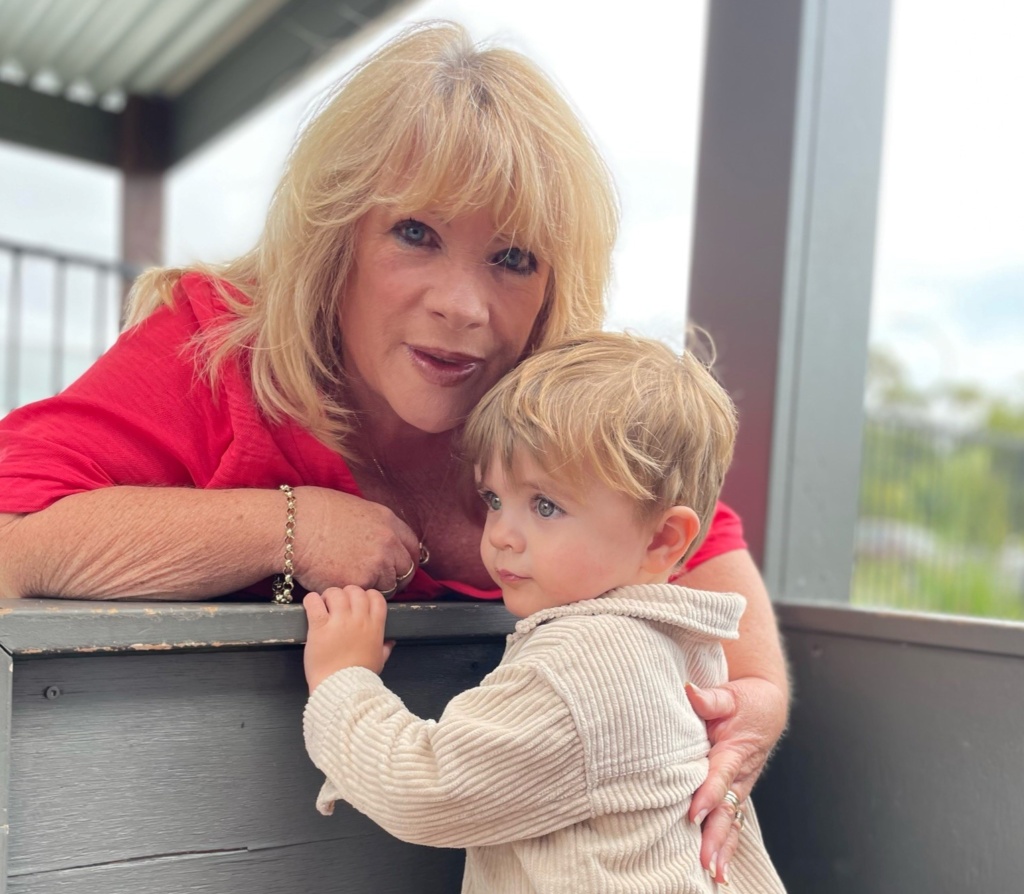
Grandparents have always shared a special bond with their grandchildren, but nowadays they are also playing an increasingly important role as a caregiver, as children spend much more time with their grandparents than ever before. Sometimes however, the generation gap can make it hard to think of new and fun things to do together that appeal to everyone.
Whether the grandchildren are spending an afternoon, a weekend, or the school holidays with you, this list is sure to keep children and grandparents of all interests and physical abilities, entertained and making memories year-round.
A beautiful day on the Gold Coast’s waterways make for some stunning views and great sight-seeing! The Gold Coast’s very own hop-on hop-off ferry is the perfect multi-generational way to spend a day. Departing hourly from five iconic Gold Coast destinations, including the famous Surfers Paradise and HOTA, Home of the Arts, you can hop on at any of the five stops, and stay aboard for the full loop (two hours) or explore the hop-off destinations at your leisure. Enjoy a drink from the onboard bar whilst the friendly captain keeps you entertained with informative commentary, music, local tips and wildlife spotting. Children can also meet the captain and have a turn driving the boat. There are a range of ticket options available, from day passes to long hops and short hops – depending on your budget and timeframes. Children under five always travel for free too!
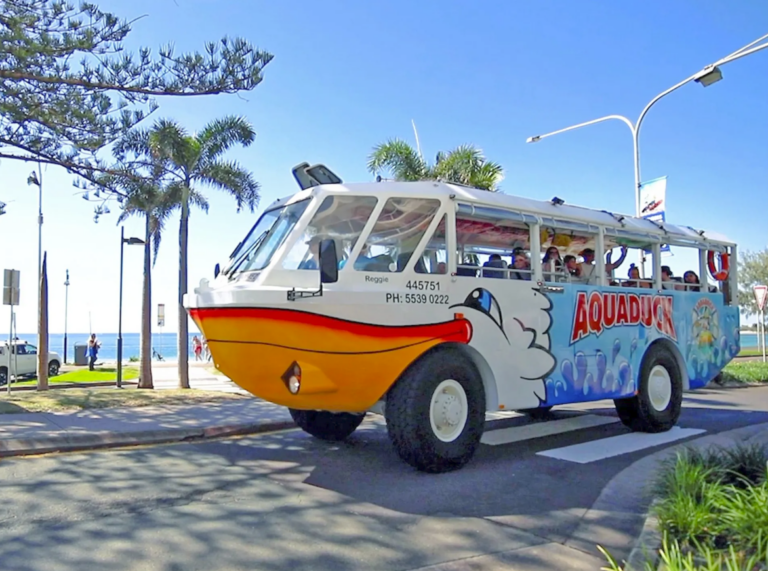
Another way to take to the water is with the iconic AquaDuck, and while it’s touristy, it’s a really great family outing, and perfect for multigenerational passengers. Embarking in the heart of Surfers Paradise, drive down the Esplanade overlooking the beautiful beaches and head towards The Spit. Once you reach the boat ramp just past SeaWorld, the tour changes pace and you’re heading for the water! Watch as the amphibious ‘duck’ changes from bus to boat and gently glides into the water. Now you’ll head through the Broadwater to check out how the millionaires live. You’ll finally return to land and drive down Tedder Avenue, before finishing back up at Cavill Avenue. The tour takes about an hour and is very family friendly, with children offered the chance to drive the boat and get their Captain’s certificate!
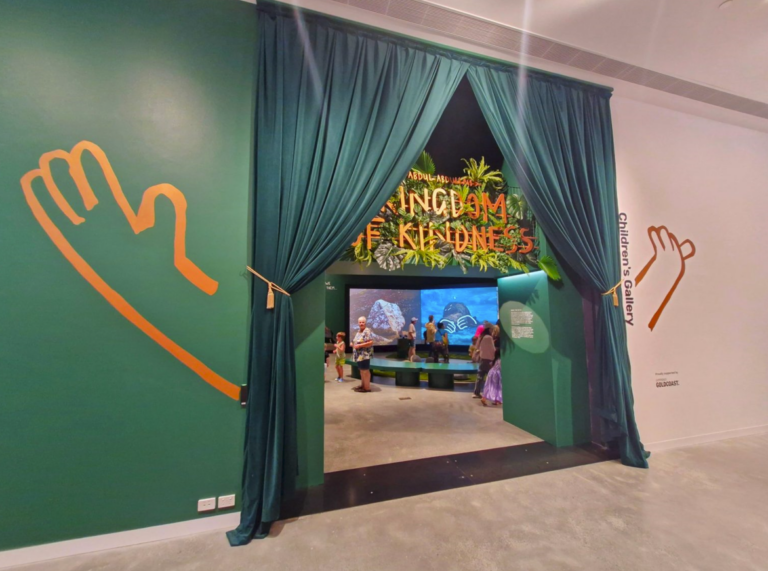
While the HOTA Gallery may be designed to cater for international art exhibitions, grandparents looking to give the grandchildren some culture will feel right at home! The Children’s Gallery at HOTA Gallery lets little artists get hands on – you won’t find any “do not touch” signs here! The Children’s Gallery changes every few months, each time offering a variety of interactive exhibits that complement the main galleries. After visiting the Children’s Gallery, take a stroll through the other free Galleries where you’ll find a few installations that are interactive and the children will love. Be sure to also ride the lift to the top floor and take in the Gold Coast skyline view! Fabulous 270 degree views await and there’s a guide you can use to work out what all the buildings are.
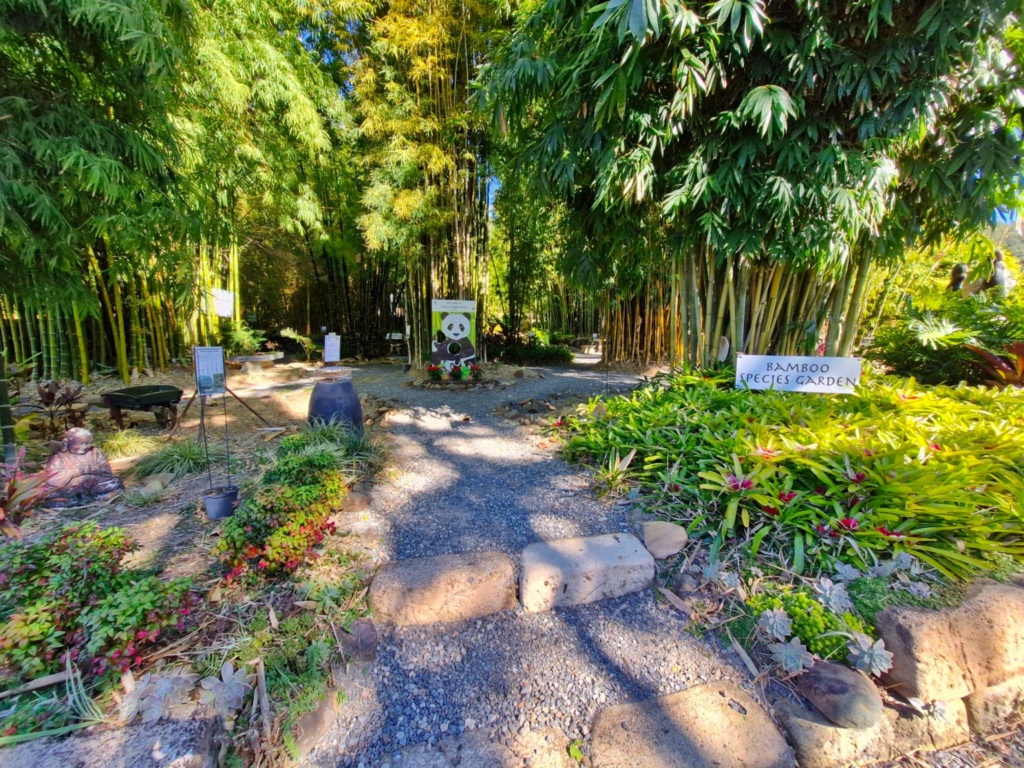
Bamboo Down Under at Wongawallan is a garden centre with a difference. The perfect grandparent’s day out, here you can explore a species garden, meditation garden, labyrinth, sensory garden and bamboo tunnel, and get bamboozled in the bamboo maze! Children can take on the Scavenger Hunt to discover the hidden pandas, all the while having a look at some incredible ornamental species of bamboo. Don’t miss the Rainforest Walk, a very peaceful stroll through a forest of enormous bamboo varieties. Dotted throughout are information signs about bamboo, little panda ornaments and other garden statues. Don’t miss the enchanted hollow at the end of the Tunnel.

The Cascade Gardens at Broadbeach has a special addition of a sensory garden designed for seniors, but it also makes for great fun for little ones! In the sensory garden you’ll find elements including a musical gong, wayfinding design and productive gardens that encourage you to interact with the gardens through sight, touch and smell. It’s a beautiful addition to the Gardens and makes this spot perfect for multi-generational get togethers! The playground is older in style, but the children don’t seem to mind. You’ll find a flying fox, rope bridge, rock climbing wall and a carousel.
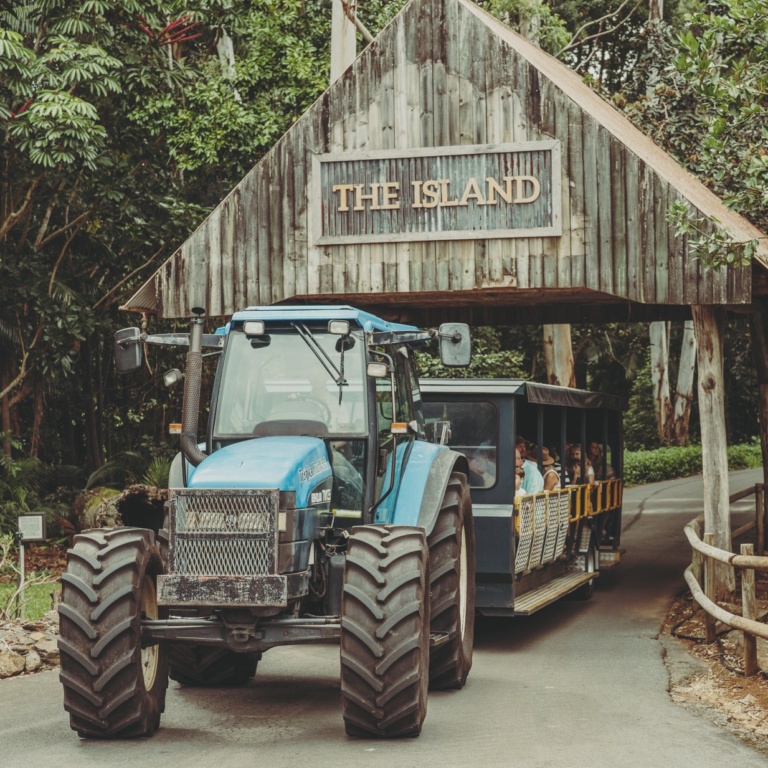
For the more active grandparents, a visit to Tropical Fruit World just over the NSW border in Duranbah is a fabulous day out for the family! Book a Farm Tour and experience a fruit tasting and a tractor-driven guided park tour. On the tour you can pick and eat bananas straight from the tree, crack macadamia nuts, feed and pat kangaroos, sheep, alpacas and miniature horses, and enjoy a short wildlife boat cruise too! At the end of the tour visit Wildlife Island and burn some energy on the flying fox, mini golf course and volleyball court. Then, check out the fruit market, café, and the huge sandpit by the grassed lawn to relax. If you live in the Tweed, Gold Coast, Byron, Lismore and Ballina, you can purchase tours at a discounted rate.
(Image with thanks to Tropical Fruit World)
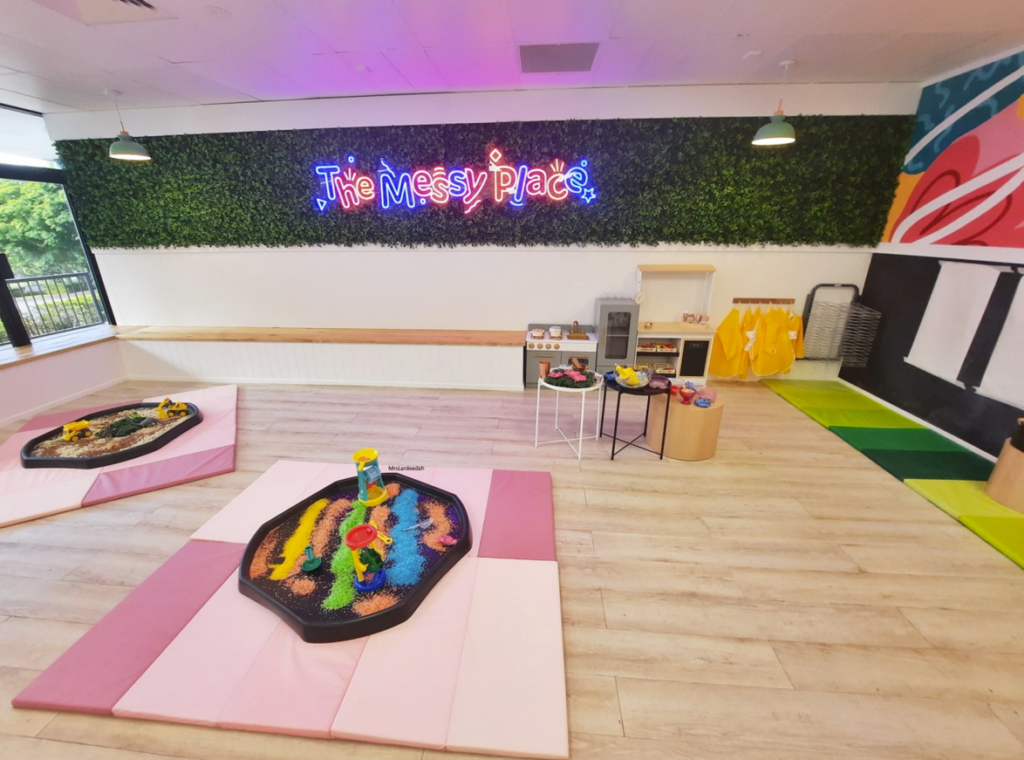
The generational gap can sometimes be hardest when the grandparents are tasked with spending time with energetic little toddlers. Keeping up with their ever-changing attention span, endless energy and natural curiosity is challenging for everyone! The Messy Place at Ashmore is the ultimate creative sensory play centre on the Gold Coast, designed exclusively for children under six years of age. They offer creative and messy play sessions in a safe and enjoyable environment, where they can unleash their imagination and make a mess. Exploration is encouraged, and grandparents can feel reassured being indoors in a secure, enclosed space. Sessions are booked on a casual basis and run five days per week.
National Grandparents’ Day is celebrated in Australia on the last Sunday of October. But as we all know, Grandparents Day is any day that the grandchildren can spend precious time with their grandparents. Whether you are a parent looking for how your child can have fun with grandma and grandpa or a grandparent seeking things to do with your grandchildren, we hope these ideas will inspire your time together.
We wholeheartedly believe in the proverb ‘it takes a village to raise a child.’ Little Scholars is proud to be a part of communities across South East Queensland, and we’re happy to play a small role in childhoods across the Gold Coast, Redlands and Brisbane.
We offer you and your child the very best facilities, resources and early educational, play-based programs available, which are underpinned by the early years learning framework. Our belief is that through quality education and care for children we can also encourage, assist and support the entire family.
Our dedicated team of educators are committed to the individual needs and interests of children and their families, and thus we encourage and welcome family input and involvement.
We aim to be like an extension of your family and are very relationship-driven. We support nurturing relationships between our educators and your child, the relationships your child has with the other children who attend, and we value our relationship with you as the parent and other family members. So book a tour today to get started!
Find Lara’s recommendations at her website Mrs. Lardeedah.com, and follow her socials Facebook and Instagram
Deception Bay is a vibrant community in the City of Moreton Bay, just 45 minutes from Brisbane. Little Scholars has proudly been a part of this community since 2018. As we gear up to open our second campus, Little Scholars Deception Bay North, in January 2025, we’re excited to share some of our favourite family-friendly activities in the Moreton Bay area. After all, we’d like to think we’re more than just early learning, we’re proud members of this vibrant community. We cherish our families and believe in building treasured memories throughout childhood.
Check out our list of 17 fun family activities, though it’s just a glimpse of what this lively community has to offer.
Images and information courtesy of the organisations mentioned below, as well as City of Moreton Bay, Visit Moreton Bay and Brisbane Kids,
Moreton Bay and surrounding areas host a number of art and culture galleries, a terrific addition to an area of about 500,000 people!
Caboolture Regional Art Gallery – In a contemporary gallery space, visitors can explore an exhibition program featuring significant Australian and international artists. The gallery showcases in-house curated exhibitions alongside touring shows from Australia’s leading visual art institutions, bringing the best of Australian art to the region for everyone to enjoy. Notably, a variety of family-friendly activities, including artist talks, workshops, and tours, are available throughout the year, making it a welcoming space for families to engage with art and creativity together.
Redcliffe Art Gallery – Redcliffe Art Gallery is the Peninsula’s premier family-friendly arts destination! With four exhibition spaces, families can enjoy a diverse range of works by local, emerging, and established Australian artists. The Studio, a dedicated public program space, frequently hosts artist-led workshops and transforms into a vibrant and popular art space for kids and families during school holidays. It’s the perfect place for families to explore art together and spark creativity in a welcoming environment!
Pine Rivers Art Gallery – a welcoming family-friendly space located on Turrbal Country. The gallery features an immersive exhibition program centered around an annual theme, showcasing collaborations with local and national artists. Families can enjoy art experiences that inspire curiosity and creativity together. Visitors of all ages can enhance their experience in the gallery’s dedicated engagement space, which hosts a diverse range of events and activities throughout the year. From hands-on artist-led workshops to fun, family-friendly programs during school holidays, there’s something for everyone to enjoy!
Bribie Island Seaside Museum – Plan your next outing at the picturesque Bribie Island Seaside Museum! Located near the waterfront and overlooking the iconic Pumicestone Passage, this museum showcases the rich and fascinating history of Bribie Island, including: video archives with stories from First Nations elders, a theatre screening films about the famous S.S. Koopa (1911-1953), insights into Bribie Island’s significant role during World War II and the story of internationally acclaimed artist Ian Fairweather. Visitors can learn about the intriguing history of Bribie Island through a variety of immersive and interactive displays, along with heaps of events and workshops throughout the year.
Redcliffe Museum – is a family-friendly destination that offers children a unique and contemporary glimpse into the people, places, and stories that have shaped this historical seaside town. The museum features: a First Nations video archive with stories about language and culture, films about the early days of the Peninsula, including the famous Rollerdome, offers a chance to rummage through memory boxes to uncover items and stories from the past. Throughout the year, families can enjoy a vibrant program of ever-changing exhibitions, events, and workshops, including the exciting Imaginarium, a dedicated children’s play space filled with various activities and crafts designed for children to create, learn, and explore.
Pine Rivers Heritage Museum is a fantastic family-friendly destination that invites children to explore the stories and significance of the district throughout history. The museum features an 1890s kit home produced by the renowned timber merchant James Campbell and Sons, the Skyring Clock Collection, showcasing 50 hand-crafted clocks, short films detailing the history of Normanby Rum, the Australian Paper Mill, and other early industries in the region, and a collection items that highlight Pine Rivers’ role during WWII.
Woodford Museum – Right in the heart of Woodford Village and only about half an hour from our Deception Bay campus is the Woodford Historical Society’s Museum. The Museum is a community exhibition hub for the history of Woodford’s early explorers and home of the Mick and Val Draper collection of miniature buildings.
The Hills District All Abilities Playground – Leslie Patrick Park is an ideal spot for a fun-filled day for all little ones! This all-abilities playground ensures that children of all physical and intellectual abilities can join in the excitement and play together.
Bray Farm “Harry Potter” Park, Griffin – Mentioned in our popular blog post about playgrounds across South East Queensland, Bray Farm Park is commonly known as the ‘Harry Potter’ park in Griffin, north of Brisbane, this destination blends art, culture, nature, and fun for the entire family. There’s two whimsical ‘cottage style’ play structures, a climbing sphere, slides, swings, and charming bridges. With a magical forest backdrop, plenty of park benches, winding paths, and a large grassy area for games, this park is sure to be a fun day out for all! Parents take note, there aren’t toilets, the park isn’t fenced and it’s close to a road, so keep an eye on your youngsters while they play!
Lightwood Parklands in Caboolture South is an impressive multistorey playground designed for older children, making it perfect for primary school age and above. The playground features a challenging multi-storey fort with a thrilling three-story tunnel slide, swings for younger children, climbing nets, and a pump track that connects to wide pathways—ideal for bikes and scooters. Additional amenities include playing fields, a basketball half court, BBQs, and accessible toilets, ensuring a fun and inclusive experience for all.
Brisbane Kids has a fantastic blog on the best parks in Moreton Bay – check it out!
Caboolture Region Environmental Education Centre (CREEC) – With more than 18 hectares of diverse native vegetation near Burpengary Creek, the CREEC has plenty of wide open spaces, as well as shady, tucked away areas for hotter days. Discover the nocturnal room, interactive educational displays, and native stingless beehive inside the centre. Entry is free. With its manicured greens, a large fully fenced, all-abilities playground, BBQs and other family-friendly facilities, a nursery, and forest trails, the iconic CREEC has something for almost everyone!
Trevena Glen Farm at Mount Samson – a great escape from the city, Trevena Glen Farm gives an authentic farm experience for families with a dozen animals on the 16 acre family farm. Families can pay to tour the farm and see horses, rabbits, chickens, guinea pigs, goats, alpacas, llama, pigs, sheep, donkeys, mini horses and a dog. Pony rides are also an option and At the heart of the farm is Trevena Glen’s iconic 130 year old Moreton bay fig tree. This beautiful tree has a multi-level tree house.
Dolphin Wild Island Cruises Moreton Island – For the adventurous types, why not try a Moreton Island cruise and snorkel experience? Enjoy an eco-cruise around the area spotting marine life including dolphins, sea turtles and dugongs feeding on the seagrass during a marine eco-tour. The company welcomes families to bring their prams on board, ensuring that parents and guardians can easily navigate the vessel with their little ones. The minimum age to participate in the snorkelling activity is six years with an ability to swim and all children must be accompanied by an adult. Lucy, the operations manager, says they do the guided snorkel tour in rotations of smaller groups so both carers can have an opportunity to snorkel if looking after children who can’t participate. Those who can’t participate in the snorkel tour can either remain on the boat or get ferried to Moreton Island beach to experience the sand dunes and shallower waters.
Osprey House Environmental Centre – The interpretive centre includes a life size dugong, bird and animal displays and the live streaming video from the osprey nest. You’ll find interesting educational displays, ‘touch’ tables and information provided in numerous and novel ways. They also offer story time sessions and school holiday programs. Explore the mangroves, Wildlife can be seen from the Mudflats, and in the Eucalypt Forest, the dominant trees above the tidal zone are Queensland Blue Gums and Grey Ironbarks – major Koala food species. Look out for the Koala that sometimes visits.
Kumbartcho Sanctuary and Nursery –This beautiful 6-hectare sanctuary, located next to the South Pine River, preserves the remaining pockets of riverine rainforest. Kumbartcho is home to an array of wildlife, including koalas, frogs, snakes, turtles, and possums. The nearby river provides opportunities to spot waterbirds, shorebirds, and even predatory raptors. Visitors are welcome to explore the sanctuary, enjoy the playground, and visit the plant nursery for a wonderful day surrounded by nature.
Settlement Cove Lagoon is a picturesque, tropical-style public pool situated on the Redcliffe Peninsula. With palms and fig trees lining the area, the lagoon and wading pools provide a perfect spot for families to relax and enjoy during the summer months. Young children will love the fenced-off water park with mushroom fountains, and a nearby playground. Settlement Cove is a great picnic spot, with barbeque areas, picnic shelters, and plenty of shade.
The Convict Trail – To learn a quirkier lesson, why not take the family along the convict trail? In 1824, Queensland’s first penal colony was founded on the Redcliffe Peninsula, marking the start of the state’s colonial history. The settlement included soldier barracks, a jail, the Commandant’s House, and various smaller buildings. Despite early progress, food and water shortages forced the abandonment of the site, leading to the relocation of the colony to the banks of the Brisbane River, now the heart of Brisbane’s CBD. Today, you can explore this fascinating chapter of history along the 1.7km Redcliffe Convict Trail, where the legacy of Queensland’s earliest settlers comes to life.
There you have it! We hope you enjoyed our list of the best things to do with your family in Moreton Bay. If you’re after the best childcare in Deception Bay, look no further than Little Scholars Deception Bay and Deception Bay North, due to open January 2025!
Contact us or book a tour today to ensure your little one gets the best start to life that they can.
Do you have a family friendly Ipswich place to visit that should be on this list? Let us know on our socials @littlescholarsearlylearning!
*Images courtesy of facilities listed as well as City of Moreton Bay, Visit Moreton Bay Region, and Brisbanekids.com.
The children, educators, staff and families are celebrating Little Scholars George Street receiving an Exceeding result in the National Quality Standards (NQS) Assessment and Rating recently.
Situated in the heart of Brisbane’s bustling central business district, Little Scholars George Street provides exceptional early learning and care for 108 children. Its unique location places children just steps away from some of Brisbane’s most iconic cultural spaces, including the Queensland State Library, Brisbane Square Library, Queensland Museum, and the Gallery of Modern Art.
Excursions like these, which pique children’s curiosity and understanding of the world, are just some of the unique offerings from Little Scholars George Street.
As Little Scholars approaches its 10th anniversary of serving South East Queensland families, the children, and the educators, are the heart of what makes this exceeding campus so special.
“Our team is incredibly dedicated to providing the best early education experience for our little scholars,” says Jae Fraser, founder of Little Scholars. “The Exceeding rating is a testament to their hard work, innovation, and commitment to the children’s development. They consistently go above and beyond to create a nurturing environment where each child can thrive, while also supporting families by making Little Scholars a true home away from home.”
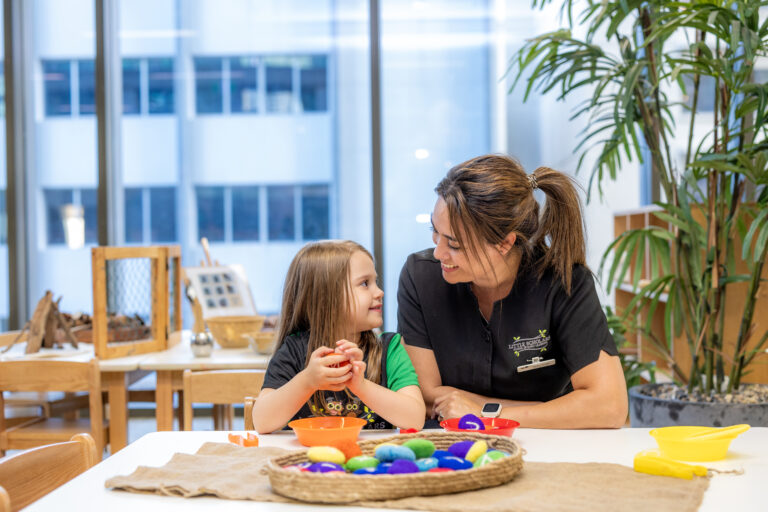
Little Scholars’ Collective Curriculum emphasises how much of its educational experiences are child led, and this was noted in George Street’s assessment.
“Educators and service leaders actively sought the perspectives, opinions, and voices of children, families, and the community,” the assessment noted.
The assessment went on to say the George Street team demonstrated a strong, ongoing commitment to meaningful, authentic, and regular engagement to inform the program.
It highlighted the collaboration Little Scholars has with families and the community supported educators in designing and implementing programs that promoted belonging, valued each person’s unique contribution, and created a sense of wellbeing and calm throughout the service.
George Street team demonstrated a strong, ongoing commitment to meaningful, authentic, and regular engagement to inform the program.
An example of this approach is the Children’s Council, a key initiative at all Little Scholars campuses, including George Street. The Council, composed of children, their early childhood teacher, and educational leader, meets monthly to gather feedback on the children’s kindergarten experience and empower them to participate in decisions affecting their campus. The child-led meetings occasionally veer off-topic, but they offer invaluable insights into the children’s interests and perspectives.
Understanding how busy its families are, Little Scholars George Street goes the extra mile to ease parents’ daily challenges. The campus offers free parking, rare in the heart of Brisbane, along with a valet service where a caring staff member greets children and escorts them to the campus.
Additional support offered to families includes a daily breakfast bar, take-away meals to simplify dinner time, and quarterly date nights, giving parents the opportunity to reconnect while their children enjoy an evening of fun with friends.
“Given our proximity to government departments, law firms, and entertainment venues, we know our parents have demanding schedules,” Jae explains. “That’s why we’re committed to providing these additional services that truly make a difference in their daily lives.”
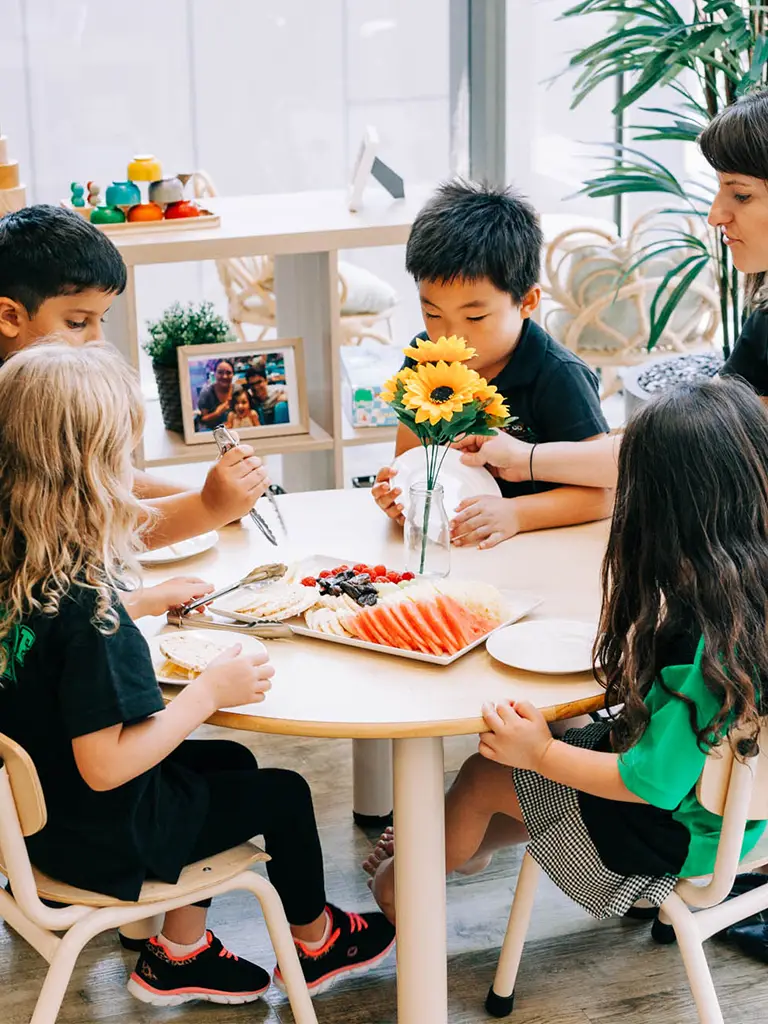
Amy Robertson, campus manager of Little Scholars George Street can barely contain her excitement, and says she’s proud of her staff, who she believes always goes above and beyond.
“Our recent assessment and rating at George Street has highlighted the exceptional quality of care and education our campus provides. We are proud to receive an exceeding rating, a testament to the dedication and professionalism of our educators,” says Amy.
“This achievement has been warmly received by our families, with one parent expressing, ‘We always knew the campus was exceeding, it’s gratifying to see the staff receive this well-deserved recognition from the Department,’” she adds.
Little Scholars George Street’s Exceeding rating reflects the hard work and dedication of its entire community, and it highlights the exceptional quality of early education and care provided at this remarkable campus.
Let us hold your hand and help looking for a child care centre. Leave your details with us and we’ll be in contact to arrange a time for a ‘Campus Tour’ and we will answer any questions you might have!
"*" indicates required fields
Let us hold your hand and help looking for a child care centre. Leave your details with us and we’ll be in contact to arrange a time for a ‘Campus Tour’ and we will answer any questions you might have!
"*" indicates required fields